The Internal Comms Podcast

Episode 107 – Beyond words: A blueprint for more impactful, immersive IC
In this episode of The Internal Comms Podcast, host Katie Macaulay welcomes international internal comms consultant and strategist Monique Zytnik to the hot seat. Monique is the author of Internal Communication in the Age of Artificial Intelligence. She has two decades of experience shaping strategies and crafting personalised, more meaningful communication experiences.
In this wide-ranging conversation, Katie and Monique talk modern-day communication strategies, and where they fall short. We discover how Monique’s early career in physiotherapy shaped her into the communicator she is today and how it has helped her tap into the hearts and minds of colleagues across the world.
We also dive into her layered, immersive and non-linear approach to internal comms and explore the importance of effort and authenticity in leadership.
As always, share your thoughts on this or any other episode of The Internal Comms Podcast using the hashtag #TheICPodcast. And thanks for listening.
Transcript
[00:00:00] Katie
Hello and welcome to The Internal Comms Podcast with me, Katie Macaulay. If you’re looking to improve communication inside your organisation, you’re in the right place. Every fortnight I invite a comms practitioner, consultant, academic or author to sit in my podcast hot seat and together we explore fresh, innovative and hopefully inspiring ways to create more meaningful, impactful internal communication.
My guest today is the seasoned internal comms expert, Monique Zytnik. An international consultant and strategist, Monique has more than two decades’ experience working across a range of different industry sectors, from government and software as a service, to healthcare, broadcasting, and engineering.
Monique is the author of Internal Communication in the Age of Artificial Intelligence. Now this book sets out a forward thinking approach to internal communication that suggests we should blend human creativity with technology to create more immersive, personalised, and meaningful communication experiences.
We cover a lot of ground in this conversation. First of all, listen out for Monique explaining the relevance of her early career in physiotherapy, and realising she could spot the exact moment when she knew her patients were going to get better. And just like in physiotherapy, where patient motivation is key to recovery, as comms professionals, we must tap into employee motivation and behaviour.
Here Monique explained her layered, immersive, nonlinear approach to internal comms, where messages are delivered through a variety of different channels and formats catering to different learning and media preferences. Monique talks about the ‘trust triangle,’ the importance of effort and authenticity, particularly in leadership communication, of pushing creative boundaries, and tapping into the collective intelligence of employees, the people who so often are closest to customers and their pain points.
It was a pleasure to interview Monique. She has a very considered, thoughtful approach to internal comms, and he’s also a fantastic advocate and cheerleader for the value that we can add inside organisations. So without further ado, I bring you Monique Zytnik. Monique, welcome to The Internal Comms Podcast. It is a pleasure to have you here.
[00:03:10] Monique: Thank you so much, Katie. I’ve really wanted to follow on from our conversation late last year with the IABC Amina podcast and have been looking forward to this one with you.
[00:03:22] Katie: I know that a lot of people say they fell into internal communication. They came from a background or a field sometimes quite different from comms.
You started out as a physiotherapist. So talk me through that unusual career pathway.
[00:03:41] Monique: I actually wanted to be an engineer originally, which is another interesting story. And I practiced physiotherapy because I couldn’t stand the sight of blood and didn’t want to do medicine. I very quickly realised that I could start to pick the day that my patients decided to get better.
All of this training and teaching about the science I felt there was something more and realised that it was about motivation and persuasion. I think there’s a lot of interesting learnings about physiotherapy or what I took away from physiotherapy as I stepped into communications. Physiotherapy is about problem solving. It’s one to one and sometimes one in a group, I did group sessions as well. It follows a pattern of SOAP, Subjective Objective Assessment Plan. Very similar to communications where you’re doing the subjective, asking people questions, listening. Then the objective, what are you observing? What’s the data telling you? In the internal comms world, what are the stats on your intranet or the data from your staff survey saying? Then you make an assessment. What’s the problem? What are you trying to achieve? That’s the strategic bit. And then what’s your plan? How are you going to get there? How are you going to solve the problem? There’s also this element of working in a multidisciplinary team that we had when I was a physiotherapist. We had a psychologist, occupational therapist, a doctor, you had the nursing staff, and everyone had their different roles and perspectives. And I think that’s where I really learned to love. Working with different people and seeing the diamond from different angles, because then you come to a more robust conclusion and you can support each other with different skills.
Extrapolate that to the comm space, you’re talking about creatives, your account manager, your digital workplace. We also had a lot of reporting, you had to measure and justify what you were doing. because the health insurance or someone was paying for it. And keep in contact with the doctors or the hospital to make sure you got the funding needed for your patients.
That was over 20 years ago. Then I stepped into my internship in Washington, D. C. right after September 11 and plunged into the comms world, into PR and marketing. And then as many of your other guests, Katie, I discovered internal communication and fell in love with the idea that once again, you’re there to create a difference. There is a business outcome. And I talk about the business side of physiotherapy as well. That was on my realisations in my book, I talk about that. We have an interesting duty of care, I believe, to our people and our organisation, which is similar to that duty of care that you would have with your patient.
And that’s what I love about the profession.
[00:06:59] Katie: I love the idea of a duty of care. What often motivates me is the amount of time people spend at work in their lives and therefore making sure that time is at least not harrowing, but ideally meaningful and fulfilling. And people are able to at least be themselves.
You talk about picking the day and being able to notice that moment, that day when your patients are getting better. That also makes me think about the importance of the behavioural sciences in our work and understanding mind states and being able to influence mind states. Isn’t that interesting, that crossover between the two?
[00:07:45] Monique: Absolutely. And that’s what I found so frustrating with physiotherapy is it’s all about the physical side and that motivational side to human nature and people wanting to do their activities. Or if you’re talking about sports people, it’s actually preventing them from doing their activities. it’s that motivation and the human side to it, which is so important.
I found it quite frustrating that was almost ignored for the benefit of the scientific approach. I think the mixture of both is really nice and I’ve brought that scientific methodology to my comms as well.
[00:08:26] Katie: You’ve worked both in house and as an independent consultant. What do you prefer and why?
[00:08:36] Monique: I love being a part of an organisation and being able to influence long term.
It’s building those relationships and being able to shift mindsets or approaches or coaching senior leaders, for example, where you get the background insights, where the leader might think that they’re doing a great job. If you’re only to be listening to the leader, you wouldn’t think there was any problems, but it’s being able to, again, pick up on that with your listening, with your connections, with your network, where things are perhaps not going so well with the leader and being able to ask the right questions and help them see different perspectives. I love that about in house. With consultancy, I think you move a lot faster and you’ve got a lot more leeway to be daring and push the boundaries, whereas in house you’re restricted by what you know is probably going to be signed off. By your in house client or in a consultancy, you’re expected to be a little more out there and can offer one or two outrageous options that, if you’re lucky, the client might go for because they’re sick of their everyday in house comms. For me, a combination of both would be ideal.
[00:09:59] Katie: Yeah. Brilliant. I want to come back to you and talk about the creative process a little bit further on in this conversation, but let’s get started with your new book, Internal Communication in the Age of Artificial Intelligence. Now it sets out this really, I think, very bold vision for a richer, more immersive, more creative, more experiential approach to internal comms.
What inspired you to write this book? There are now quite a few books on the markets around internal comms. Was there a particular message or gap in the market that you felt needed to be addressed?
[00:10:39] Monique: So Katie, my book is the first internal communications business book for leaders, to help them communicate effectively at scale.
And there are three key areas that I wanted to address in writing this book. One is that I had been working with 3D immersive technology and realised the techniques and theories we have, if you think of Berlo’s Sender Receiver, that was the 1960s. If you think about Facebook, enterprise social networks, that’s all emerging around 2007 onwards.
Then where we are right now is the start of the fourth industrial revolution, which has the metaverse blockchain and AI. They’re the characteristics. And the way we communicate is much more experiential. We don’t have a model for that, and this is what I’m offering Katie, a model that incorporates these new techniques to help us make sense of it and choose wisely when we create our strategies.
The second is also through my conversations. I again realised that our leaders, they’re great at one to one or one to a team, but when you’re communicating at scale, you need that strategy component, otherwise it can be very hit and miss. I’m hoping to achieve with my book is helping leaders understand the ones that have got the budget and who get to sign off on things, why it’s important to be strategic.
There’s also a need to link tactics to the biggest strategy. In some ways, strategy is still a bit of a dirty word in some areas of our profession, and it’s still very tactics focused. What I’m trying to do with my model is you can pick up on a tactic and step back and see how it fits into a bigger strategic model. And it can help you identify the elements that you might be missing. Maybe you’ve missed out on the feedback. Maybe you’ve completely forgotten about the measurement. Maybe it’s a more complex comms plan where you need immersive communication techniques, but you also have to remember the fundamentals.
It’s really, a big picture tool to help with these three things.
[00:13:05] Katie: Perfect. That explains, it’s a book for the, as you say, for the modern age and the age when we have so many more interesting, sophisticated, immersive, richer tools at our disposal. This episode of The Internal Comms Podcast is brought to you by the Internal Communication Masterclass.
I’ve condensed more than 30 years of experience and expertise into this unique on demand learning experience. Gain the capability, confidence and credibility to turbocharge your career. There are eight work streams in this, which you can buy individually or as one comprehensive learning journey. Each work stream comes complete with a downloadable course book filled with yet more resources and some compelling homework tasks.
Visit icmasterclass.com. This is an entirely on demand program, so you can learn at your own pace, anytime, anywhere. Plus there’s no expiry date, so you can revisit the content at any time. whenever you wish. That website address again, icmasterclass.com. And as a listener of this show, you enjoy a 20 percent discount on each work stream or the entire program. Simply use the code podcast20 at the checkout. Stand out from the crowd, gain that promotion and feel re-energized and inspired.
Let’s step back a little bit in order to frame this entire conversation. I love the fact that very early in your book, you set out four ways internal comms can bring value to organisations. Honestly, you think that debate has been had you think we don’t have to prove our worth anymore, but I’m surprised by how often I do have to start in that place with some leaders and say, yeah, internal comms is a value adding function. Talk to me about those four ways that we add value.
[00:15:22] Monique: Katie, it’s more important than ever that we talk about the value add that we offer. It’s more important than ever that we help explain these to our leaders. With all of this change coming up, the way internal communications needs to shift to still be seen and still be a viable profession in the future is up to us.
And the reason why I talk about this at the start of my book is because, as internal communication professionals, we do a lot of navel gazing. We know what the research is. We know what the best practice is. We know why it’s good. But we don’t communicate that in a way that makes sense to our leaders from a business perspective.
My book, I lay out corporate communication. The second one is organisational listening, effective change and transformation and streamlining communication. Now this is, I have to confess, not the be all end all. Because I actually chunk up with the corporate communication, this is about things like reputation, both internally and external, and research. So Rita Men from the University of Florida has done some great research on this. that demonstrates that employees rate the organisation better and perceive it as being more transparent when you’ve got excellent internal communications in place. This flows from the internal through our employees to external reputation because your employees are really your best advocates.
This is particularly important when we look in the recruitment space. With corporate communication, we also have the employee engagement experience and alignments. piece. And research shows that there’s a direct link to the bottom line. Then we’ve got the organisational citizenship behavior, which is minimising that destructive behavior. So the rule breaking behavior. people filling a part of the company, minimising people stealing from the company and also the damage to the reputation that they could cause. Then if I spring across to the organisational listening, which is the second one, we’ve got under that, we’ve got business insights that a lot of leaders don’t think about. They don’t realise that If they’re able to harness the intel, and we’re talking about data, we’re talking about information, business intel from their frontline staff, and able to quickly, which technology now allows, get that back up to their decision making process, they can make better decisions.
Our frontline staff know what the issues are with products because they’re in contact with the customers. They know the pain points for the customers. They know how things can be done better. I remember at the IABC World Conference, there was Oscar Mundos, who is the former CEO of United Airlines. The first thing he did was went on a listening tour, I think it was for 36 days, his first job as a CEO, because he understood that those business insights from listening to your employees can help you make better decisions and do better business.
Then the third one is effective change and transformation. And that’s if you have a fancy car in your garage, but you don’t bring it out and actually use it, it’s not really worth the money and a lot of particularly change transformation people forget that it’s important to spend the time in communicating that change.
And then the last one is streamlining communication. One of the biggest issues we’re facing right now is information overload. Yeah. And that’s what our employees are suffering from.
And a lot of research shows that’s contributing to workplace stress and mental health issues. So that’s why I pulled those elements out in my book.
[00:19:33] Katie: And just to double down on the point about change and transformation, we have McKinsey, three consultants from McKinsey on the show not that long ago, who said that 80 percent of Transformation programs fail to reach their stated objectives, and sometimes it’s actually more than 80%.
A lot of the reason for that being poor, or missing, or inconsistent communication. So yeah, completely agree with those four, thank you.
You advocate for this multi layered, immersive approach. And I really want to get under the skin of this approach and understand what it looks like in practice. this richer, more engaging, more impactful communication experience.
Let’s start with multi layer internal comms. So what does that start to look like in practice, on the ground, inside an organisation?
[00:20:30] Monique: So the multi layered internal communication model layers from the foundational that we were talking about with the sender receiver, using networks, taking a facilitation role with networks and communities, and then the immersive on top.
And it’s held together by leadership communication and strategic alignment components. That’s the model. What it means in practice is when you have a strategy, you’re able to use the model to work out, how complex is what you’re trying to communicate? What’s the environment like? Is it something that people are going to understand easily? Is it informational? Or is it like these transformational projects where you need a lot of richness to it? And it’s about layering these different components together and being able to use this model as a tool to have conversations with senior leaders. So that when they say, Hey, I would like to have a video, let’s communicate our new culture strategy with a video that you can say hang on.
That’s one directional, how are we going to get feedback if it’s working? How about we add in all the elements to our strategy so we get that result over time? There’s a lot of misunderstanding from a leadership perspective that one piece of communication is going to make a difference. Or the opposite sometimes happens that if you bang someone over the head enough times with the same bit of information in the same way, people are actually going to understand it.
And so this model recognises the nuances and how things need to be layered, almost like a cake. Or if you prefer a toolbox full of tools that are used for different things. You’ve got to know what you’re trying to fix first and then select the right tools in the right sequence to get the results.
[00:22:40] Katie: Yeah. And as you were talking about the old model of send a receiver broadcasting messages at people, which is where we get cascades from, and you and I have the same slight problem with cascades, I think. How far that’s moved, because I’m thinking of Mike Klein’s work on network analysis and influences inside organisations. And I guess that’s a vital part of your talk here, I’m guessing.
[00:23:06] Monique: Absolutely. And Celine Schillinger, who wrote Dare to Unlead, and that’s one of the books I wish I’d read in full before I published my book, because it’s brilliant. She’s doing some really interesting work at the moment where she’s got a network of women in a Arabic based company, and she’s networked their different not only jobs, not only backgrounds, not only qualifications, but also how they’re connected to each other.
And through this tool that she’s got, they can even use it for predicting who’s got leadership potential and qualities based on the network. There’s some really amazing stuff you can do once you start to think clearly in these areas about what you want to achieve and how you can go about mapping networks and identifying those influences and being able to use that. Say if there was an emergency and you needed to ensure something was spread quickly through an organisation, who would you first call upon? And you can nurture those people as well. Mike’s done a great job. Some work in this space.
[00:24:18] Katie: Yeah, it’s fascinating work. We’re doing this with a client at the moment to identify those, they’re calling them connectors, but influencers, and then supporting them with the skills and the capability, the confidence to turbocharge their influence and connection ability. It’s really quite exciting.
Immersive communication I’m picturing this as something that almost touches all our senses. Would that be a good way of describing it?
[00:24:45] Monique: Absolutely, Katie. It’s where you put your audience in the center of the experience. It’s experience based and it’s about reducing the friction between the message and receiving the message.
And instead of it being about the sender, it’s about the actual audience receiving in, as you said, multisensory. We forget that people prefer to receive things in different ways. Some people are more auditory, some people are more visual. Then it’s about being nonlinear. So starting to think about how can you package up your messages or your communication pieces so they make sense individually but also as a whole, and it’s not so gentlemental if they’re received in a different order than intended. And this is particularly important for asynchronous work.
And then the third one is the gamification and the interactivity, which we already know is important, but it’s about being deliberate with it and not getting someone to play a game just for fun. It’s about being intentional with your communications and how you do it. So yeah, it’s got those three elements and you don’t need immersive technology to use these immersive communication techniques.
[00:26:10] Katie: That makes perfect sense. A few things immediately spring to mind. Non linear. Isn’t that interesting? We’ve got a communication plan. Phase one, we do this. Phase two, we do this. Phase three, and we assume that everyone is waiting there, saying, when do I get phase two? I’ve just had phase one. I can’t wait for phase three.
That is not how people work. That’s not how organisations work. That’s not how teams work. I’ve been on holiday. I’ve been absent for whatever reason. I’ve missed something because I’ve been super busy. I love the fact that you’re thinking about packaging things up to make sense as they arrive to you. Yes, they join up, but if you’ve missed something, you haven’t missed anything crucial.
[00:26:49] Monique: I first came to, I first came to that realisation actually, I was working on a project with DHL, the Virtual Strategy House. So it was a 3D environment. It’s one of the case studies in my book. And that’s the moment where we had this multi story house that explained different parts of their corporate strategy, all mapped out.
There was a big warehouse, for example, to represent the DHL warehouse and there were different corners of the warehouse that were assigned to different parts of the business. I just assumed people would go through from front to back. And then when I looked at the actual data, like we could tell what people are clicking on and where people are watching.
Some people started from the back. They went all the way to the back of the room and started there. And then it became about what other assumptions are we making? And then we realised that, for example, in Australia, we drive on the left hand side of the road as we do in the UK. So people start on the left.
In Europe, people drive on the right hand side of the road. As soon as you start to think about that… I saw other designs for other 3D spaces being created, because this was during the metaverse hype during the COVID era, people putting floor stickers on the floor as to where you had to walk from. Yes.
Whether you had to go through the immersive experience clockwise or anti clockwise and that completely takes the ownership away from the person. And if we do go back to physiotherapy, this is one of the things I learnt all those years ago. is people have to want to get better themselves. They have to want to learn themselves.
You can’t force feed people and you can’t make anyone do anything. Sometimes you can with threats and bribes, but if they have ownership and choice in the process, it’s impactful. And that’s ultimately what you’re trying to do is you’re trying to cut through and make a difference with your communication and with the experience rather than imposing it upon somebody.
[00:29:25] Katie: I love that idea of choice because how often do we create something that is a once and done thing? If we use technology in the way that technology now enables us to create content, for example, you could choose your language. You could choose the 30 second version or the 20 minute version. You could choose just to watch it or just listen or just to watch the animation.
There’s so many different ways now that we can create our content and give people choices. So I love that so much. Just coming back to your floor vinyls and your floor stickers, with hybrid working, and lots of things have to be communicated via screens and devices. But I have often thought to myself, what a wasted opportunity the physical space often is.
I think we need to earn people’s commute, and I’m not sure we’re doing that with the physical spaces that we offer people at the moment.
[00:30:17] Monique: I absolutely agree with you, Katie, and this has been one of my frustrations watching the hybrid office scenario unfold over the past couple of years when I was in Australia working for the Australian government a year or two ago, and we did a big hybrid return, a sort of return to work project.
It was almost like employees being told you have to come back to the office or else, but there was no, as you said, offering, like why some people were spending huge amounts of money for parking, because the public transport where wherever they were coming into the office was terrible. They had to drive. Then parking was horrendous, because you had to pay for the whole day parking.
What are you offering your employees in exchange? And then we discovered the employees. were in the office, but on a video call, all of them sitting behind their desks on a video call with someone on the other side of the country. And again, you think, what kind of experience is that? And I think there’s so much opportunity for workplaces and also where communication consultants can come in, and look at the workplace experience. We haven’t really, for example, experimented with smells in the office. I don’t know if that’s going to be a thing, but temperature, that’s really important, even sound, like how can we give a better experience to people where they can concentrate more effectively, and not have this echo y office environment where everyone’s talking on a video call with someone else from somewhere else?
What opportunities are we giving people to come together? With my team in Australia whenever we had enough team members, I’d take a team member out for a coffee. Or just sit down with someone and ask them how they were and have those personal conversations which are much richer in person when you can sit next to each other, look someone in the eyes and feel their pain when they talk about their stress or their personal family experience.
It helps you as a leader, support them better, but unless you’re offering those experiences to people when they come in the office., Then it’s wasted.
[00:32:47] Katie: I couldn’t agree more. One of the linchpins or the drivers of your model has to be creativity, doesn’t it? Because we are going to need to think in far more creative ways about how we take our strategy, our plan, and lift it up and make it something that we can touch, you can feel, you can sense, you can interact with.
Talk to me a little bit about the creative process here, because I see that as quite a challenge for some in house teams. Would you agree?
[00:33:22] Monique: Absolutely. And as I alluded to at the start, Katie, it’s because there are limitations within an organisation as to what you know you can get away with, perhaps what the in house team is, maybe they’re doing the right thing and being a real stickler for the brand guide, and sometimes As Bettina in my book says, you need to scribble a little bit over the edges and you need to. I love, yeah, I love her analogy, and sometimes it takes someone or a team from outside of the organisation to offer fresh ideas, to push the boundaries, and be that excuse, it’s oh, the consultant recommended it. And then the internal comms person is saying with a smile on their face to the leader, the experienced consultant from outside the organisation proposed this and it’s based on best practice. I think there’s a lot both can learn from each other and lots of benefits being in house and in a consultancy.
The consultancy can draw on all of those examples that they’ve managed to get across the line in different organisations.
[00:34:38] Katie: Yeah, and hold the hand of clients that might be feeling a little bit nervous. Have you come across an example where this works without a lot of digital capability? Because a lot of the time, not all organisations have immersive technology at their fingertips. They have to do it slightly more old fashioned ways,
[00:34:59] Monique: I think it’s a matter of whatever works. Immersive communication is about appealing to the senses. If you’ve got a big video conference for whatever reason, if you’ve got the budget, then why don’t, can you send the employee something in the post? So they’ve got something physically there. Or I did some work with a client, a European engineering company, and they had a lot of clients who were in, I don’t know what you call the suites. I’m sure there’s a proper word for it in the confectionery area. And we asked the participants on this big online event to go to their local supermarket and buy specific products from their clients, so that they had them there and they could consume them together as a part of the experience. Yeah.
There are little ways and it’s just about being creative and thinking, how can we bring more audio into this or how can we make it more interactive? For example, I have the ‘doing it tandem style,’ a case study in my book, which was a different German engineering company who was working together with a consultancy and they wanted to work more closely together and have that shared understanding. And one of the things they did was they had a strategy cooking show, and one of their senior leaders popped on a hat, everyone was behind their computer. Yeah. They did a bit of a cooking show with props and had a lot of fun, but it was based on strategy and the ingredients were different parts of the strategy that they had to put together and mix.
So there are fun ways that you can do that. There are photos and screenshots from this event where the team members, they’ve got their hands in I’m trying to demonstrate on a podcast, so it’s not really working, Katie. But doing not quite aerobics, but activities together, which really had that sense of being a part of something, a sense of belonging.
[00:37:17] Katie: Yeah. We’ve had I think we’ve had virtual yoga. We’ve had all sorts of things at AB. So yeah, even when you’re apart, you can be together doing something. You can be connected in a way and share an experience. I absolutely love that idea. I’m tempted to ask you quite a difficult question, but it’s one that a lot of our clients are grappling with at the moment.
We are being asked to review, audit and streamline channels at the moment. If you could wave a magic wand and create the perfect channel suite, what core features and functionality would you have in your perfect channel suite, do you think?
[00:37:57] Monique: Katie, it’s with all comms, you actually need to have something that suits your organisation, and I’m not talking about your organisation and your people right now. It’s a mixture of what legacy channels have you got in place. Because there’s obviously a history there that people prefer to use certain things in certain ways. Then it’s like, where do you want to go to? What’s your ideal situation?
For example, you mentioned the language translation. If your business is only operating in an English speaking or Spanish speaking company, that’s not really going to be a priority for you in terms of your Channels, having that functionality. And it’s also about thinking about what resources you have to support the different channels.
There are a zillion channels that you can have, but unless you’ve got the resources to support it, it’s not a smart idea if you’re a completely virtual company, so everybody’s working remotely, are you going to be investing in digital signage? I don’t think so. Looking at where you are and how things are currently used, what the gaps or the issues are, and also where you want to get to and then working backwards, like what are the quick wins that you can do? With your channels to tidy them up and then what investments and how much money have you got to bring in new channels? And again, I’m sorry to be talking high level, but what are your foundational, so you’ve got email, you’ve got messaging, then what’s your enterprise social network situation? Is there some sort of, again, this is the second level on the model? And then the third level is what kind of tools and functionality can you, you put in place to add those additional elements to the channels? What’s your matrix in the end? And can you clearly communicate it to your people? This is what you use Teams channels for. This is what you use Viva Connect for. This is where you find your information on your intranet, which is what we’re going to keep updated and that’s the single source of truth. These are the channels that we have. It’s about simplification.
[00:40:23] Katie: It’s really interesting because a lot of the time I think just a simple picture on one page. When I start with an organisation, this is the channel landscape. This is what I can expect to receive when I can expect to receive it. And this is the purpose or objective of each of those channels. that doesn’t exist inside so many organisations. That would be a great place to start before you change anything.
[00:40:51] Monique: So a couple of points there, Katie, when I was working with a global communications consultancy, we did a audit of a a company and they had Dropboxes where they were keeping PDFs for the salespeople on the products. And it’s don’t they use Microsoft Teams? They could have that on their phone.
And it was like, oh no, we just use Teams for video calls. So again, it’s like looking at the functionality and how can you streamline it and simplify the different channels and help, going back to that point about the transformation, how can you help people understand what they’re used for? This is particularly important because some research came out the other day that directly links information overload and FOMO, fear of missing out, with workplace stress, mental health issues. But what’s interesting about that is, if people know where to get the information and that the information is going to come to them from the CEO message every Monday, they know where to look for, or they have, and that again, consistency, Katie. It reduces the anxiety. If you’re checking multiple channels, there was an organisation I worked at who had two messaging systems. They didn’t know if it was going to come to you on Teams. You didn’t know if it was going to come to you on Teams. Jabba, which is a Cisco program. And you didn’t know if people were going to try and reach you on a video call with which system, and then obviously the systems don’t like each other. So yes, you’ve got to buffer in five minutes to get your headset connected with whatever video call you’re trying to be on, yeah. Yeah. I think simplifying, sometimes putting some old technology to bed, saying goodbye before we add on.
[00:42:53] Katie: And I think you’re right. My Microsoft partner, Silicon Reef, tells us all the time that only about 30 percent of the features and functionality. in any kind of platform is actually used. The vast majority of features of functionality are never touched by their clients.
So it’s often not necessarily a brand new channel suite, it’s just understanding the full power and potential of what you’ve got. And I couldn’t agree more about familiarity. These constant interruptions that we are giving people by sending things out on an ad hoc basis unexpectedly. If I know at two o’clock on a Monday or five o’clock on a Wednesday, I know what I’m due to get, I always get it. It’s always in the same format. It says what it does on the tin, as it were, then that’s no longer noise. That’s expected. It’s anticipated. I know the purpose. I think that’s so important as well.
[00:43:50] Monique: That’s where being strategic and planned with our communications can really help.
[00:43:55] Katie: And I’m wondering if we can squeeze a quick conversation in about trust here because you have a trust triangle, I believe. You have defined the core elements of trust, do you want to talk to us a little bit about your research into trust and where you’ve ended up in terms of how you define it, or how you create it?
[00:44:13] Monique: Sure, Katie, I would love to say that I’m the creator of that, creator of the triangle. Unfortunately, the triangle was there before me, but the elements of what you do and what other people say about you combine to form trust.
This links to that conversation about consistency being essential for leadership communication at the moment. And it’s when all these three things align that people tend to trust you. We can influence what we say and what other people say about us. Jeff Bezos’ famous quote, “your personal brand is what other people say about you when you’re not in the room.”
So we can influence that in terms of being conscious about the narrative that we’re sharing with people, how our stories fit together to support this overall narrative. This is where. The personal branding and leadership communication comes in, and I would strongly encourage any leaders who are listening to huddle up with your internal comms and your comms person because internal and external need to align and be really clear about: what is your narrative? What are the pillars or what are the key topics that you talk about? And how do you demonstrate that in your everyday work? If your narrative is about caring for the environment and you talk about how this is important to you and you’ve got your origin story, we can delve into Seth Godin because he does lots of great, he talks about that in a really great way.
Then adding on to that, how can you share those elements through different stories that you tell in the workplace? And how can you demonstrate? In a physical sense, are you giving your employees a couple of days off to do volunteer work for the environment? Are you sparking conversations and allowing people to have robust debates on these topics in your organisation? This is where all those elements fit together, and where an experienced communication professional can support leaders in helping them consciously through what they say and what they do and influence what other people say about them as well.
[00:46:50] Katie: Let’s pull on that thread about origin stories because there’s pet theory of mine that there’s an origin story inside almost every organisation that doesn’t get told as powerfully as it should.
And what it always comes down to is a series of milestones across the timeline, which is never a story.
[00:47:13] Monique: It’s like I was born, then I went to school, then I went to high school.
[00:47:18] Katie: And that’s not your origin story. It is your timeline and it’s a totally different thing.
[00:47:22] Monique: And obviously origin stories can change over time. There’s no problem or issue with that, but it’s picking the right story that explains where it’s at now. and why certain decisions are being made.
[00:47:37] Katie: As you say, organisations can have them, people can have them as well, as a way of explaining your background, your vision, your values, your hopes and aspiration.
It relates to individuals as much as it relates to organisations, doesn’t it?
[00:47:52] Monique: Absolutely. Yeah. Absolutely. That’s what’s so powerful about it. And in my physiotherapy background, until I really delved and, worked out why I switched professions and what did I bring from my previous profession? What makes me different as a communication practitioner compared to someone who might have come from say a visual design background and being a typesetting expert that’s a different story, a different person who brings different skills. Why am I, Monique Zytnik, so passionate about strategy, about getting results, about measurement, about taking the big picture approach? And that’s what I discovered through reflecting on what changed my opinion and made me the practitioner I am today.
[00:48:54] Katie: Whether you’re in house or a freelance consultant, it helps to differentiate you and your approach because we do not all need cookie cutter internal comms people. We need that diversity of thought.
So it does help you differentiate yourself, which I think is really important. And you’re more likely to attract the colleagues, attract the clients, attract the jobs that fit for you if you share your origin story, yeah.
[00:49:18] Monique: And Katie, are you able to share yours?
[00:49:25] Katie: Listeners will probably know this because I’ve said it before, but I grew up wanting to be Lois Lane.
For me, it was all about words, asking awkward questions, getting to the heart of an issue, finding the story and sharing it with everyone. Being first to the story and getting the real story. I don’t think that’s changed. I think I’ve built an entire career on asking questions.
[00:49:48] Monique: But I think, Katie, if we look into the future and what I was able to do, the scary fact that I can go to a website and my blog asks me what I’d like to write a blog about and I just describe it and it will write it for me.
If we look at that and reflect on what the skills are that we as practitioners will need into the future. Asking the right questions is absolutely, if not top of the list, one of the top of the list, because AI is designed to please us. Unfortunately, someone’s going to ask the difficult questions, don’t they?
Someone’s got to challenge and be able to question decisions. And there’s a certain skill in being able to do that in a very diplomatic way and manage your stakeholders to get the needed results. For example, saying, Oh, that’s really nice that you want to do a video, but have you thought about this? Or what’s the reason, like what problem are we trying to solve here?
Yeah. These are the consultancy skills. They are absolutely where our value add is and the ones that we should be celebrating and talking about. I know that we need to be good at prompt engineering, but we need to be showing people that we are business partners. We’re there to solve communication problems.
[00:51:16] Katie: There’s a lot of talk about organisational listening, but I often think, what are we listening to? Without asking the right open question, we’re not necessarily hearing the feedback we need to hear. People either won’t tell you, don’t trust being open and transparent, don’t think you’re interested. There’s lots of reasons why you can have a listening ear, you can be listening out, and there’s a deafening silence.
You have to encourage and foster that kind of dialogue. It isn’t just about having a listening ear. I don’t think that’s always enough.
[00:51:53] Monique: Katie, if I can build on that. I think it’s about using all of your senses when you listen. It’s looking at the numbers and the data, but it’s also observing. We’ve got a return to work policy and you’re supposed to be in the office four days a week. Everyone says that they’re in the office, but nobody seems to be in the office. There is asking the right questions, but there’s also a lot organisations can pick up on with listening, whether it’s from a data perspective or people being on the ground, you’re just doing that observational part.
[00:52:34] Katie: I love observational research. The wonderful thing about observational research is no one lies, because you are simply watching what is actually happening. When the team brief happens from the shift manager, for example, or when the all hands team meeting happens, what is actually happening and just being there.
Walking round a factory site and just looking at the posters, the signage, the touch screens, how are they being used, where are they? How dusty are they? all of that. I tell you, it just brings me to one of my favorite stories from health and safety officer. ’cause I asked him how effective his posters were and he said, one, put it this way, Katie, I turned them all upside down the other day and it took a month for anyone to tell me that they were upside down. So they had literally become wallpaper. But that’s the kind of observational research. You don’t need to do a survey. You just need to walk in and look, and that tells you so much.
[00:53:29] Monique: I love that story because a lot of the time we think that there is no way to get feedback from a poster, it’s just there, but obviously you can.
[00:53:41] Katie: Yeah, absolutely.
[00:53:42] Monique: If someone notices there’s something wrong.
[00:53:44] Katie: I’ve seen everything. I’ve seen QR codes on posters are obvious way that you can then link the paper with the physical. But even I’ve seen clever things done with these posters, where you tear off a bit of the poster that’s got some number on it or some feedback mechanism. There’s all sorts of ways that you can be more creative with your process.
You mentioned AI there, and I’ve heard you say in the past, your content is cheap and it is very cheap if you just put a prompt in and then cut and paste onto LinkedIn. And I’m worried that is happening quite a lot when I open LinkedIn these days.
Are there any AI tools that you particularly enjoy using that you think, Oh, that’s become quite a favorite go to AI tool?
[00:54:27] Monique: There are a lot of tools that organisations should be using if they’ve got the budget and that’s the challenge of budget, and also, what organisations are allowed to use. I actually love Canva.
It sounds really silly, but I love Canva and I do appreciate the AI tools that are now embedded in basic Microsoft products. A lot of people don’t even… they think, Oh, we don’t have Microsoft Copilot. But there’s things like the audio to text in Microsoft Word that are super useful. I remember a couple of years ago, having an interview with a senior leader and having to spend such a long time typing it out.
In fact, Katie, one of my earliest jobs in comms was in the premier’s media unit in Victoria. I had one of those little digital tapes, the tiny little ones that go in a dictaphone. And I had a pedal that you’d press on that would stop the tape recorder as I typed out, and now you can just open up Microsoft Word, upload the digital file and it spits out the different speakers and a fairly good transcript and that’s a matter of seconds and it would take me hours. I wasn’t very good at typing, much better now.
[00:55:50] Katie: You’re so right. PowerPoint, for example, one of my guests explained in PowerPoint, there is a rehearsal coach. You open it up, you hit this. I can’t exactly remember where it is, but we’ll put it in the show notes. You present and the little AI coach in the corner of your screen talks to you about how fast you’re going, how slow you’re going. Brilliant. It’s all embedded in the basic version of PowerPoint. So I think you’re absolutely right. There’s a lot in our everyday tools and my guess is that’s how AI is going. We’re just going to see the everyday tools get a ,little bit smarter. I’m noticing this with Grammarly, Headliner, with Otter, getting that little bit cleverer.
It’s offering me another bit of choice or creativity. So yeah, I think that’s definitely the way we’re going.
[00:56:33] Monique: I don’t think people need to freak out about AI. It’s just about working out what you’re trying to achieve and checking to see if what you’ve already got allows for that. If it doesn’t, quite often that tool or functionality will become available. That’s the current argument for things like Gemini or Microsoft Copilot, it might not be perfect now, but if you get on board and start playing with it and understand how it works, then when it gets better and it will do that very quickly, then you’ll be up to speed. I don’t see it as any huge challenge and no need to do loads of research on the internet. It’s about identifying what would make your life easier and then working within the boundaries provided by your organisation.
[00:57:22] Katie: And I think also your budget yeah, absolutely. But also testing and piloting and trialing things. There’s quite a few clients that are testing and piloting chatbots, intranets have been for years places where people just can’t find things archives of dusty information and the actual thing that you want to find is buried somewhere and someone once sent you a link on an email but you can’t find it anymore.
Whereas the chatbot just enables you to ask a question and it comes immediately back with a result and you don’t need to know where that result was originally, you’re just given the answer. And chatbots most of them that my clients are talking about to me at the moment are in their infancy. They’re still plugging away, giving them the right information, testing them out, helping them learn, connecting them to another data point, another database. I think we’ve got to get used to playing with these things, haven’t we, as well? Lose the fear.
[00:58:20] Monique: But now’s the time to be moving from play to productive. That’s my message to all of the communication professionals listening today. Yes, playing’s great, But you need to start to shift that to something that you use on a daily basis. As things develop, there’ll be more parts of your processes, more things that you do where you can bring in different AI elements and things that you’ll discover in your Microsoft or your Google products that you didn’t know were there yesterday that are certainly there today.
So it’s about consciously and deliberately using these products in a productive way.
[00:59:01] Katie: Just a side question on that. Synthetic media. I didn’t go to Shel Holtz’s presentation at IABC World Conference. I really wanted to, but I was speaking at the same time . I was so frustrated. Where do you stand on this?
So we can have the CEO stand up and give his or her presentation in Mandarin, in Spanish. They don’t speak those languages, it doesn’t matter, it’s still… does it matter? It’s that person’s voice, synthetically created to speak in those languages. Where do you stand on all this? I’m curious, because it does raise that question of authenticity, doesn’t it?
[00:59:41] Monique: It does, absolutely. And it comes back to all of our comms Katie. What’s the purpose of it? For example, Rewe, which is a German supermarket chain, are using AI avatars, which are like a big hologram in a box. It’s not actual hologram technology, but it looks like a hologram of a head of digital workplaces.
And it’s based on a real person, looks like a real person. It’s his voice, he can answer questions you have about the company or about your leave entitlements. Wow. And it’ll answer there’s a lot of experimentation going on. The initial claim is that employees are comfortable because it’s available 24 7. Employees feel that they can ask questions that they might not ask their manager. Yes. It is early days and I already know as well that people are sending out personalised videos from their CEOs. Hey Katie, thank you so much for the great work that you’ve done today. We’re doing great stuff and we’re going to be hitting our end of financial year targets.
I just need you to stay the course for the next two months until we really get ourselves over the line with our business goals. That’s already been done. One of the really interesting conversations I had at the World Conference was with Kevin Hanlahan from Halo and Frank Wolfe from Staff Base. We had a big chat about employees being able to choose how they receive their communication. So you mentioned a couple of things about languages and being able to choose language earlier. But actually deciding, okay, I just, I want to have a audio summary of that CEO’s message, or do you want a written version? What’s your communication channel and medium preference as Katie? So I think that’s really interesting.
For example, a friend of mine’s chief of staff at a very big organisation, she said that her CEO wasn’t a native German speaker and went to the effort of learning, of having a speech written that she helped him with and he learned it. And he presented in German to all of his executives and the kudos for the effort was worth it. The respect he got for doing that was worth it. So I think we need to remember those things with the personalisation side of things. You still get brownie points for effort.
[01:02:22] Katie: Human beats machine again. Handmade by human. That’s my prediction that we’re going to see on things, this is all me. And as you say, you’ll get brownie points for it being really you and really making that effort. I like that a lot.
[01:02:38] Monique: This is already happening in the music industry where you can have a digital recording studio with digital instruments, and you can select a function that puts imperfections into your recording to make it sound more natural. Wow. And I’m wondering if that’s the way that we’re going to be going with our comms is like the deliberate typo.
[01:03:01] Katie: Yeah. Wow. What an interesting thought. The Harvard Business Review case study about the, I think it was Volkswagen, but they introduced a model of car, which was very efficient and rarely broke down, but they had this amazing customer service model in the background and no one was using it. So they put some minor fault on the car so people would experience the wonderful aftercare service.
We’ll have to find out whether that’s really true. It might be apocryphal tale, but anyway. Before we go to those quick fire questions, I’m going to ask you one of my favourite questions to ask authors, which is, what’s not in the book? Is there a topic that you would have liked to have included, but for whatever reason you didn’t? Or might be the subject of another book one day?
[01:03:52] Monique: So the challenge I have is that my book is designed to be a business book. I had a page and word limit to operate within. I’ve had a lot of very helpful people after my book is published saying, Oh, you should have included this, or this could have been included. Mainly specialists in that area. I had to deliberately not include things to emphasise other things. But I would love to include more about narratives, particularly Frank Wolf’s book came out a month before mine, so I didn’t get to read it unfortunately, and I would have loved to include some of that sort of narrative, the bigger picture narrative and how the stories fit in. And also a little bit more about a non hierarchical leadership, I think would have been interesting for a book for leaders to better understand that. And that’s Celine Schillinger book that I would have loved to have interviewed her and put that in as well.
[01:04:59] Katie: I want to remind listeners that our show notes are comprehensive and links to everything that Monique’s mentioned will be in the show notes.
This episode of The Internal Comms Podcast is brought to you by my very own Friday Update. Would you like a short email from me, never more than five bullet points long, giving you my take on the week’s news from across the world of communications? This might be the latest reports, books, podcasts, conferences, campaigns that have caught my eye during the week.
I always limit myself to just five nuggets of news so you can read it in record time but still feel a little bit more informed. Hopefully a little uplifted as you end your week. Now, this is subscriber only content, which was initially intended just for AB colleagues and clients. I don’t post this content anywhere else.
So you do need to sign up, but that is super easy. Simply go to abcomm.co.uk/friday. We just need your email address and it’s equally easy to unsubscribe at any time. So give it a go that sign up page again abcomm.co.uk/friday. And if you do choose to be a subscriber, I very much look forward to being in touch.
Let’s turn to those quickfire questions, Monique, if that’s okay with you. What’s the most important skill or trait that comms professionals will need to succeed over the next decade?
[01:07:01] Monique: Consulting skills. And that’s the questions, Katie, that you were talking about. It’s being able to ask difficult questions. It’s being able to problem solve. It’s being able to challenge in the right way.
[01:07:17] Katie: How would you complete this statement? World class internal communication is…
[01:07:24] Monique: Effective.
[01:07:26] Katie: I. e. know why you’re doing it in the first place. Have a goal and measure against it.
[01:07:31] Monique: Absolutely. I just, I see, I see so many campaigns, not so many, but I do see campaigns or things being done where the comms person is the party person, and there is no clear business objective with whatever event they’re being asked to run or it’s very top down and they’re completely missing the empowerment of the employees and giving them that ownership. My speciality is picking up campaigns that have failed or that are flopping along the ground and pulling that together and making them work.
[01:08:16] Katie: Yeah. Yeah. What piece of bad advice or unhelpful thinking has consistently dogged the communication profession?
[01:08:28] Monique: I think we navel gaze too much and we don’t think about how our profession is being perceived. I was speaking to a digital communication expert the other day and their perception of internal comms was that we wrote the newsletters.
[01:08:45] Katie: Still that perception. Yeah.
[01:08:47] Monique: We talk amongst ourselves, but we don’t seem to have deliberate campaigns to explain what we do to other areas of the business. One of the first things I do with a new comms leader is encourage them to go on a listening tour and present what comms can do for the different stakeholders within the organisation. Set out the service offer.
[01:09:11] Katie: And finally, the tradition on this show, we give you a billboard for millions to see. What message would you like to put on your billboard, Monique?
[01:09:23] Monique: People come first, technology merely enables.
[01:09:27] Katie: Nice. Neatly sums up this whole conversation, I think. Thank you very much, Monique.
[01:09:34] Monique: Thank you so much, Katie. I’ve really enjoyed our conversation, and there are so many questions I have for you as well.
[01:09:40] Katie: It could always be a part two.
[01:09:42] Monique: And thank you as well for all that you do for the comms community.
[01:09:46] Katie: Oh, it’s a pleasure. It’s a pleasure. I get to meet lovely people like you Monique, so why wouldn’t I?
And that is a wrap for this episode of The Internal Comms Podcast. As always, listeners, you can find all the links mentioned in today’s show, including a full transcript, on our website. Just head over to abcomm.co.uk/podcasts. If you did enjoy this episode and found it valuable, I have a small favor to ask. It would be great if you could take a moment to like rate or even review the show on your favorite podcast platform. This just gives the algorithms a little nudge and makes it easier for your fellow comms professionals around the world to discover our show. We have got some fantastic episodes lined up in this season, not least an interview with the one and only Seth Godin, so you might want to hit that subscribe button today. A huge thank you to Monique for sharing her insights today. And a big shout out to the dream team behind the scenes at AB. My producer John, sound engineer Stuart, content manager Madi, designer Rob, and the rest of the incredible crew at AB who keep this show on the road.
And lastly, but definitely not least, my heartfelt thanks to you for choosing the Internal Comms Podcast. Please do keep reaching out to me on LinkedIn. Tell me what you like, what you want more of, less of. I genuinely want this show to be as helpful as possible to you. Lovely listeners, until we meet again, stay safe and well, and remember, it’s what’s inside that counts.
Jump to
How Monique’s early work as a physiotherapist led to her internal comms career [03:22]
Which is better, in-house IC or IC consulting? [08:26]
An exploration of the themes of Monique’s book, Internal Communication in the Age of AI [10:39]
The four ways internal communicators add value to an organisation [15:22]
Making the case for a multi-layered, immersive approach to IC [20:30]
What makes a perfect channel suite? [37:37]
The ‘trust triangle’ [44:05]
The benefits of using all the senses when listening [52:03]
AI tools you should be using as an internal communicator [54:14]
Quick-fire questions [1:07:00]
Links from this episode
Get your copy of Monique’s book, Internal Communication in the Age of Artificial Intelligence
Discover Berlo’s SMCR Model of Communication
Explore Linjuan Rita Men’s research into internal communication
Listen to McKinsey & Company on The Internal Comms Podcast
Read Mike Klein’s work on network analysis
Check out Celine Schillinger’s Dare to Un-lead
Get insights from Frank Wolf’s book The Narrative Age
Elevate your PPT presentations with advice from Melissa Marshall
Recent episodes
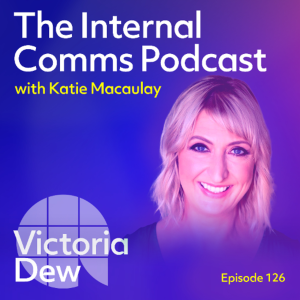
Cracking the frontline code – with Victoria Dew (#126)
November 5, 2025
In this episode, Katie welcomes back the Internal Comms Podcast’s MVP, founder and CEO of Dewpoint Communications Victoria Dew. Back in 2022, Victoria featured on episode 61 of ...

Ryanair’s exercise in efficiency – with James O’Connor (#125)
October 22, 2025
Ryanair flies 200 million passengers to 37 countries in 600 aircraft, a huge operation with a pop-cultural reputation for cheap cheap flights and frank, tongue-in-cheek communicati...
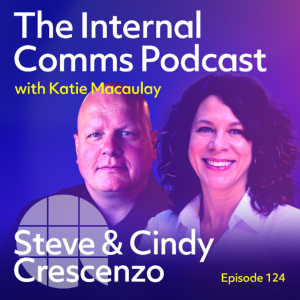
Kicking corporate clichés to the curb with Steve and Cindy Crescenzo (#124)
October 8, 2025
Episode #124 of the Internal Comms Podcast is a joint interview with returning guest Steve Crescenzo and his business partner and wife Cindy. Together, with host Katie Macaulay, th...

Don’t post, participate – with Roger Christie (#123)
September 24, 2025
In this episode, host Katie Macaulay learns how to get social media right. Tough ask? Not when you’ve got Roger Christie on hand to help. For the past 15 years the founder of ...

The science of happiness (and why we get it wrong) – with Professor Catherine Sanderson (#122)
September 10, 2025
Season 14 of the Internal Comms Podcast kicks off with a conversation about happiness. Host Katie Macaulay welcomes Professor Catherine Sanderson to discuss what really makes us...

Episode 121 – The story behind Bupa's elephant
June 25, 2025
In this episode of The Internal Comms Podcast, Katie Macaulay is joined by Jo Hudson, Group Director of Internal Communication at Bupa. Jo has spent the past 16 years at Bupa, one...
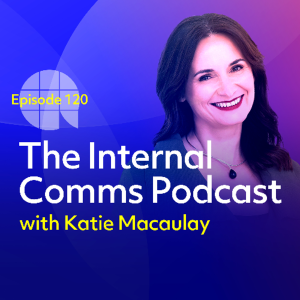
Episode 120 – Walk the line – how to stay in sync
June 11, 2025
In this episode of The Internal Comms Podcast, host Katie Macaulay sits down with alignment strategist and leadership coach Zora Artis to explore a crucial question: how can intern...

Episode 119 – The suite spot – Microsoft minus the mayhem
May 28, 2025
If the platforms you use at work were built by Microsoft, this episode is essential listening. Katie is joined by Alex Graves, Chief Visionary Officer at Silicon Reef — the peop...

Episode 118 – Satirising the spin – a bullsh*t investigation
May 14, 2025
If you have ever found yourself circling back, touching base, breaking down silos or leveraging strategic synergies — then these guests are speaking your language. Charles Firth...
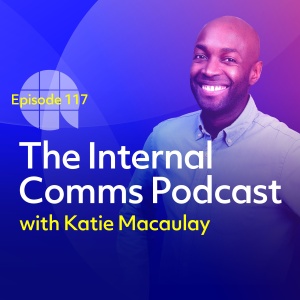
Episode 117 – From humanising a prime minister to empowering the quietest voices
May 12, 2025
What does it take to make one of the most scrutinised leaders in the world feel relatable? And how do we build internal comms that truly include everyone — especially the quieter...
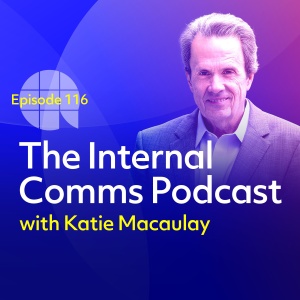
Episode 116 – How to build a remarkable career without a plan
April 7, 2025
Fred Cook’s career proves success doesn’t require a straight line. Now Chairman Emeritus of global PR agency Golin, Fred has spent 35+ years advising world-famous brands – Am...

Episode 115 – Curiosity, creativity & the imposter myth
March 26, 2025
Inspiration is everywhere when you stay curious. That’s the thread running through this episode of The Internal Comms Podcast, where Katie Macaulay welcomes communication, creati...

Episode 114 – The credibility code: Become the leader your team deserves
March 12, 2025
What does it mean to be a credible leader? And just how important is that credibility to your team? In this episode of The Internal Comms Podcast, host Katie Macaulay welcomes back...
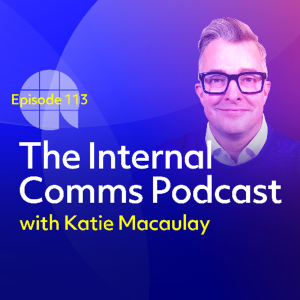
Episode 113 – Soft skill? Think again: The hard truth about storytelling
February 26, 2025
In this episode of The Internal Comms Podcast, host Katie Macaulay welcomes Jeremy Connell-Waite, Global Communications Designer for IBM, an acclaimed speechwriter and storyteller,...
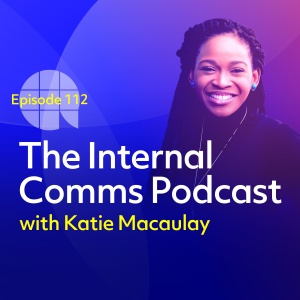
Episode 112 – From intent to impact: take charge of your career
February 20, 2025
We’re back for season 13 of The Internal Comms Podcast and to kick things off, host Katie Macaulay is joined by Eduvie Martin. Eduvie is Group Communications and Engagement Manag...
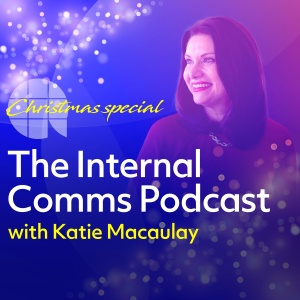
Season 12 – 2024 Christmas Special: nine gifts from the archive
December 18, 2024
In this episode, we mark a big milestone with a gift-wrapped edition of the Internal Comms Podcast. It’s six years since the show launched and, in this Christmas special, host K...
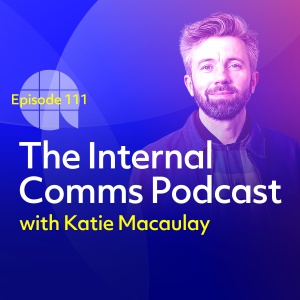
Episode 111 – A creative leader's blueprint for brilliance
December 4, 2024
This week on The Internal Comms Podcast, host Katie Macaulay is joined by a very special guest – AB's creative director, Joel O’Connor. Joel has been with AB for well over a de...
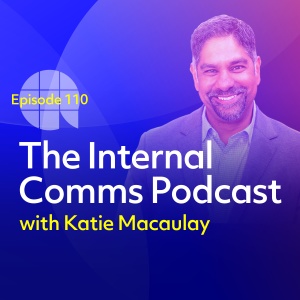
Episode 110 – Navigating the shifting digital landscape
November 20, 2024
This week on The Internal Comms Podcast, host Katie Macaulay is joined by co-founder of Local Wisdom, tech expert and comms leader Pinaki Kathiari. With his rare passion for both t...
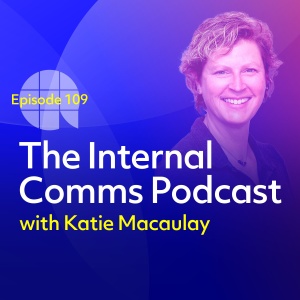
Episode 109 – The business of belonging: A new approach to DEI
November 6, 2024
We all deserve the opportunity to thrive at work. We deserve equal opportunity. We deserve to feel valued and included. That’s what diversity, equity and inclusion (DEI) is all a...
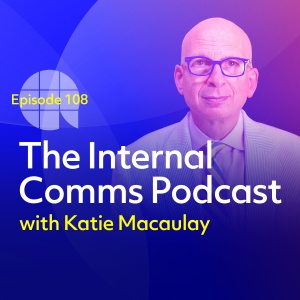
Episode 108 – Seth Godin rewrites the rules of internal communication
October 23, 2024
In this episode, Katie Macaulay is joined by author and influential blogger, Seth Godin. Seth was top of Katie’s guest wish list when The Internal Comms Podcast launched five ye...

Episode 107 – Beyond words: A blueprint for more impactful, immersive IC
October 9, 2024
In this episode of The Internal Comms Podcast, host Katie Macaulay welcomes international internal comms consultant and strategist Monique Zytnik to the hot seat. Monique is the au...
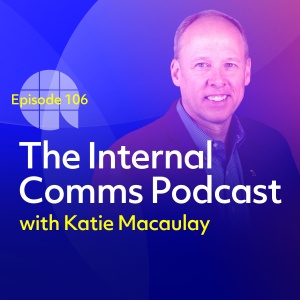
Episode 106 – School of thought: Inside Matt Tidwell’s comms curriculum
September 25, 2024
In this episode of The Internal Comms Podcast, host Katie Macaulay welcomes Matt Tidwell to the hot seat. Matt is a consultant, communicator and educator, and has led comms agencie...

Episode 105 – Reaching the peak of success: IC at Iron Mountain
September 11, 2024
We’re back for Season 12 of The Internal Comms Podcast, and in this first episode, host Katie Macaulay is joined by Senior Director of Corporate Communication at Iron Mountain, N...
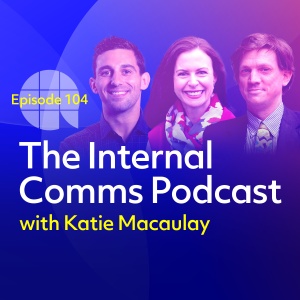
Episode 104 – Communications excellence in times of rapid change
July 31, 2024
McKinsey & Company is one of the world’s most renowned strategic management consultancies. With a mission of striving for “change that changes everything”, its global team of...
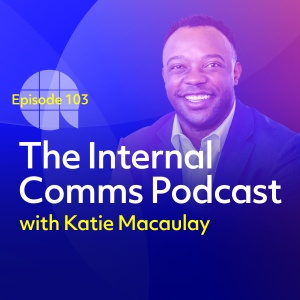
Episode 103 – Say the thing now: Candid conversations at Reddit
July 10, 2024
On a platform where the candid and the curious are king, how do you make sure what’s inside reflects what’s on the outside? Meet Sean Langston, Jr., Head of Internal Communicat...
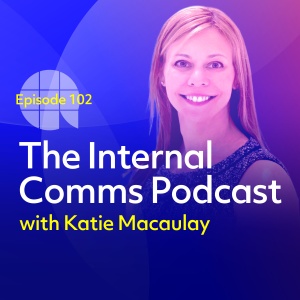
Episode 102 – The sound of success: IC at Spotify, Mastercard and beyond
June 26, 2024
Ever been curious about how some of the biggest brands in the world tackle their internal communication challenges? Well look (or listen) no further. Kerri Warner, this week’s gu...
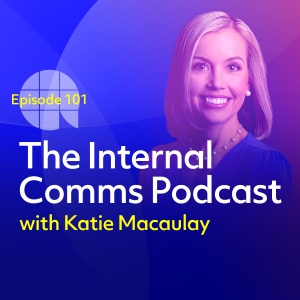
Episode 101 – From complex to clear: Elevate your presentations
June 12, 2024
As internal communicators, empowering leaders to clearly communicate business strategy, important updates and company values is a valued skill. How can we inspire colleagues and le...
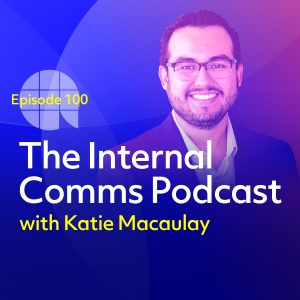
Episode 100 – Meet the super-connector behind #CommsJobs
May 29, 2024
After years running an internal communications team, Daniel Mendez emigrated from Chile to the U.S., where he faced a host of barriers to success. A language barrier. A small or no...
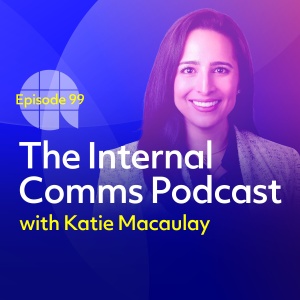
Episode 99 – The communicator’s communicator
May 15, 2024
In this episode of The Internal Comms Podcast, host Katie Macaulay is joined by Linda Zebian. The very first Director of Communications at PR management platform Muck Rack, Linda s...
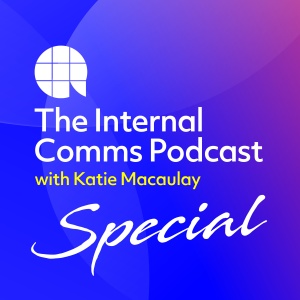
Exclusive reveal: Katie’s IC masterclass
May 1, 2024
Join us for a special episode of The Internal Comms Podcast as host Katie Macaulay announces the imminent launch of her unique on-demand masterclass. With more than three decades ...
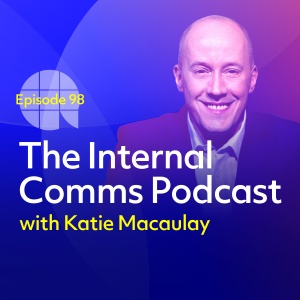
Episode 98 – How to build a powerful personal brand
April 17, 2024
This week on The Internal Comms Podcast, host Katie Macaulay is joined by serial entrepreneur, author, keynote speaker and business mentor Chris Ducker. Chris is a renowned expert ...
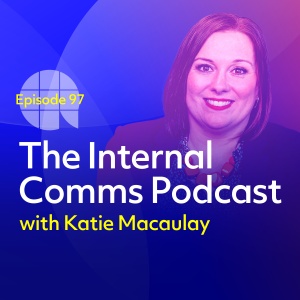
Episode 97 – Leaving the ladder down: helping IC pros step up
April 3, 2024
In this episode of The Internal Comms Podcast, host Katie Macaulay welcomes back the show’s first-ever guest, Rachel Miller. Rachel is an internationally recognised internal com...
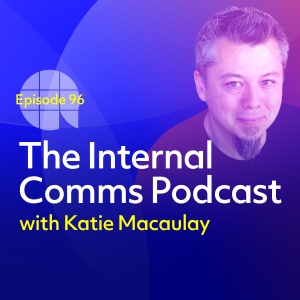
Episode 96 – Inclusion in action: Kindness is the keystone
March 20, 2024
This week on The Internal Comms Podcast, host Katie Macaulay is joined by Global Belonging, Equity and Impact Consultant, and self-styled ‘human-centric technologist’, Bob Wata...
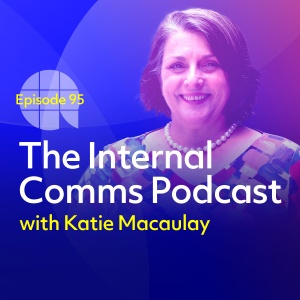
Episode 95 – Mastering your approach to strategic communication
March 6, 2024
This week on The Internal Comms Podcast, host Katie Macaulay is joined by award-winning marketing and communications expert Danielle Bond. Recently retired from corporate life, Da...
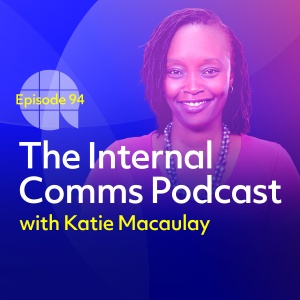
Episode 94 – The stories that shape us
February 21, 2024
In this episode of The Internal Comms Podcast, host Katie Macaulay is joined by leadership communications coach and co-founder of Engage Kenya, Agatha Juma. Agatha credits an emba...

Episode 93 – The sound of success: Why it pays to listen to employees
February 7, 2024
We’re back for Season 11 of The Internal Comms Podcast! And kicking us off with a very special episode, this week host Katie Macaulay is joined by not one, not two, but three gue...
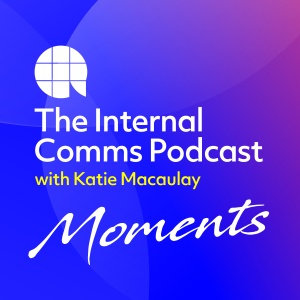
Moment 35 – The four Cs of content: How internal communicators can create comms that land
January 31, 2024
Looking for tips on creating internal communications that land – and stick? In this Moment from The Internal Comms Podcast, Steve Crescenzo shares a few things you absolutely mus...
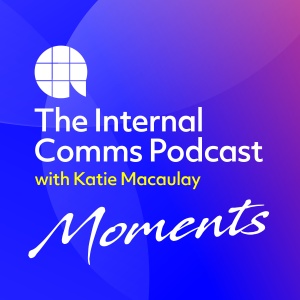
Moment 63 – Are you listening? The power of questions in leadership: Mike Roe
January 24, 2024
“I realised I was probably a pretty crap listener,” Mike Roe tells Katie Macaulay in this Moment from The Internal Comms Podcast. We often go to leaders and start by asking th...

Moment 57 – Language matters: Building two-way engagement at IKEA
January 17, 2024
At IKEA, choosing the right words when communicating with the workforce is everything. Guy Britt, IKEA’s Global Head of Co-worker Comms, tells Katie Macaulay the use of ‘co-wo...
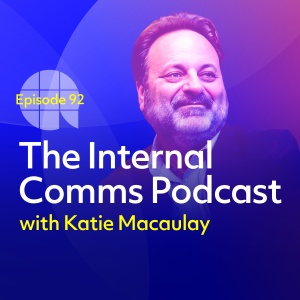
Episode 92 – Revolution coming: How AI is transforming internal comms
December 20, 2023
If you have ever attended one of Shel Holtz’s presentations, you will know that, more often than not, it’s standing room only. Shel has a remarkable ability to anticipate what'...
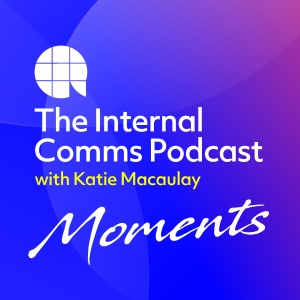
Moment 61 – Human-centric businesses do better: Victoria Dew
December 6, 2023
Does your approach to internal communication have the human touch? It’s essential to the humans you employ, says Victoria Dew, CEO of Dewpoint Communications and an internal com...

Episode 91 – How to build a one-person IC powerhouse
November 22, 2023
Ever feel like, as an internal communicator, you’re fighting an uphill battle all by yourself? This week’s guest on The Internal Comms Podcast has exactly what you need. Host ...
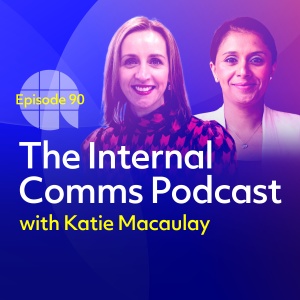
Episode 90 – A shared vision: ED&I and IC in action
November 8, 2023
This week on The Internal Comms Podcast, host Katie Macaulay is joined by Sim Sian, Head of Equality, Diversity and Inclusion at Mitie, and Yvonne O’Hara, formerly Mitie’s Grou...
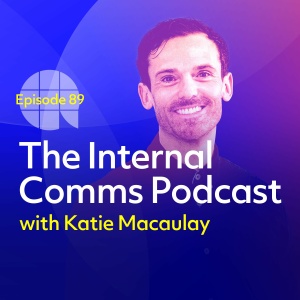
Episode 89 – Netflix-style IC: Snackable, on-demand and authentic
October 25, 2023
In this episode of the Internal Comms Podcast, host Katie Macaulay is joined by Access Group’s Global Head of Communications and Engagement, Paul Downey. Paul caught Katie’s ...
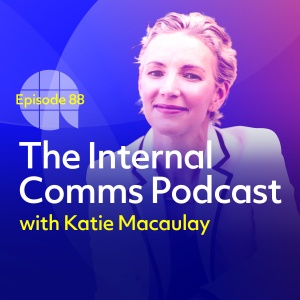
Episode 88 – It’s fixable: How to tackle hard problems
October 11, 2023
In this episode of the Internal Comms Podcast, host Katie Macaulay is joined by Anne Morriss. Anne is an entrepreneur, author, public speaker, and the Executive Founder of the Lea...
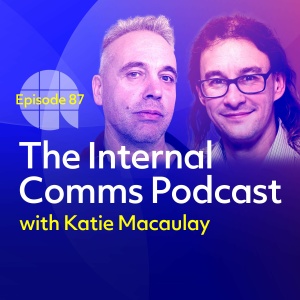
Episode 87 – Tracing the legacy of internal comms
September 27, 2023
It’s often said we must understand the past to build the future, and that sentiment sits at the very heart of this episode. This week on The Internal Comms Podcast we welcome pr...
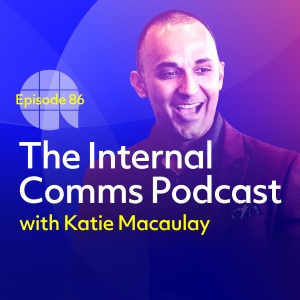
Episode 86 – How to crush your next public speaking gig
September 13, 2023
Season 10 of the Internal Comms Podcast kicks off with one of Katie’s most compelling conversations yet. Shil Shanghavi is a public speaking specialist, storyteller and head of...

Coming soon: Season 10 of The Internal Comms Podcast
September 6, 2023
Our summer break is drawing to a close, Katie has dusted off her mic and we’re ready to launch Season 10 of The Internal Comms Podcast! This season, we’ll be welcoming more o...

Moment 18 – 3% of employees are driving 90% of conversations: Mike Klein
August 30, 2023
In this moment, we catch up with Mike Klein, former political consultant, modern-day communications stalwart, and two-time guest on the Internal Comms Podcast. Mike breaks down h...

Moment 17 – How we create meaning: Sue Dewhurst & Liam FitzPatrick
August 23, 2023
What’s our one true purpose as internal communicators? It’s the question we’re all seeking the answer to. This moment takes us back to when Katie first welcomed Sue Dewhurs...
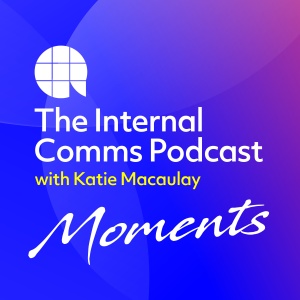
Moment 13 – The message must change at each leadership level: Dr Kevin Ruck
August 16, 2023
If there’s one thing we’re clear about at AB, it’s that communication should not be a one-way street. And that’s what this moment is about. We head back to Episode 13, w...
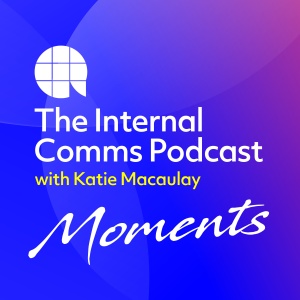
Moment 06 – On tolerance, kindness and being enough: Henry Normal
August 9, 2023
As communicators, we could often do with slowing things down a little. In this moment, Henry Normal – author and co-founder of production company Baby Cow, which he founded with ...

Moment 01 – What happens inside is reflected outside: Rachel Miller
August 2, 2023
Have you heard of an inside-out approach to communication? It’s no secret that today’s internal comms messages seep into the world outside the office walls. After all, anythi...

Episode 85 – Lessons from a trailblazer
July 26, 2023
We’re ending Season 9 of the Internal Comms Podcast with a bang this week, as Sally Susman takes to the hot seat for her second appearance. Sally is Executive Vice President an...
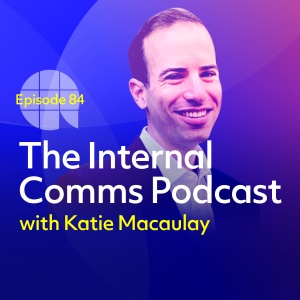
Episode 84 – Ethics in action: Insights from a global compliance leader
July 12, 2023
In modern business, integrity is non-negotiable. As legislation ramps up in lockstep with colleague and customer demands, operating an ethical business in line with global regula...

Episode 83 – ESG: How IC can drive the agenda
June 28, 2023
Define ESG… Well, it stands for environment, social and governance. But can you really define what ESG actually is? Put very simply, ESG is a set of criteria used to evaluate a ...
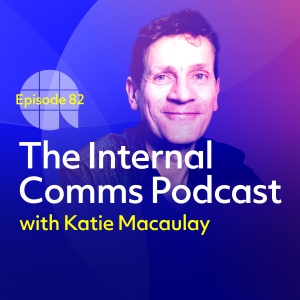
Episode 82 – The truth about resilience
May 31, 2023
It seems everyone’s talking about resilience, the ability to bounce back from misfortune or adversity. But as Bruce Daisley explains to host Katie Macaulay, there’s something w...

Episode 81 – Unilever: Inside a global success story
May 17, 2023
With over 130,000 colleagues, and a 100-year history, Unilever is one of the world’s largest consumer goods companies. And this week on the Internal Comms Podcast, we get a peek ...
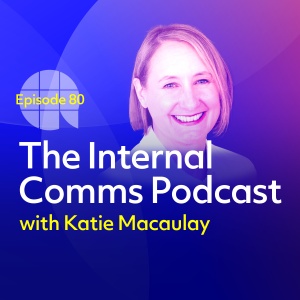
Episode 80 – The inside track on comms at Mercedes F1
May 3, 2023
“The days we fail are the days our competitors live to regret,” said the late, great Niki Lauda. And that’s what this episode of the Internal Comms Podcast is all about. Thi...
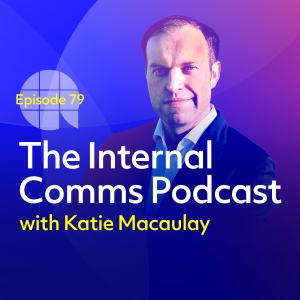
Episode 79 – Lifting the lid on comms consultancy
April 19, 2023
Ever considered what it takes to become an effective communications consultant? Then this week’s episode of The Internal Comms Podcast is for you. Host Katie Macaulay welcomes Si...
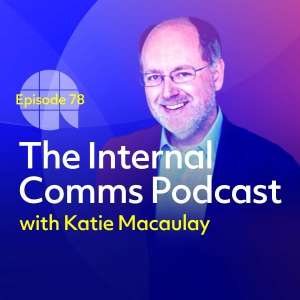
Episode 78 – Comms with courage
April 5, 2023
This week on The Internal Comms Podcast, host Katie Macaulay welcomes Audacity’s Jason Anthoine. Jason has spent three decades working in internal communication, employee experie...
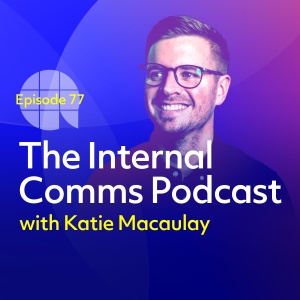
Episode 77 – Here for the culture
March 22, 2023
This week on The Internal Comms Podcast, host Katie Macaulay welcomes culture-chameleon Shane Hatton. Shane is many things – author, international speaker, trainer, leadership co...
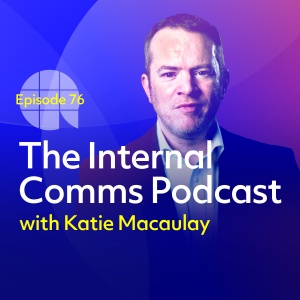
Episode 76 – Employee experience: For the people by the people
March 8, 2023
This week on The Internal Comms Podcast, host Katie Macaulay welcomes Nicholas Wardle. Nicholas is Head of Employee Experience at Brand Experiences, and co-author of ‘Monetising ...
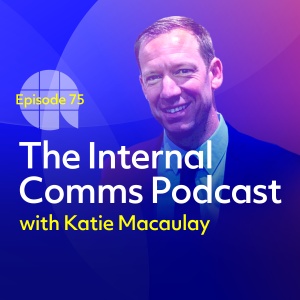
Episode 75 – Inside the world’s most famous corner shop
February 22, 2023
This week on The Internal Comms Podcast, host Katie Macaulay welcomes Sam Bleazard. Sam’s role as Employer Brand Content Producer takes him behind the scenes of ‘the world’s ...

Episode 74 – Culture with sticking power
February 8, 2023
The Internal Comms Podcast is back for Season 9! To kick off this season, we welcomed BizJuicer’s Andy Goram to the hot seat. Andy’s passion for building businesses ‘from t...
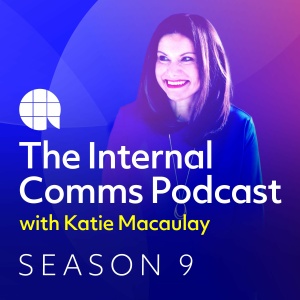
Season 8: In the rear view mirror
February 1, 2023
With Season 9 of The Internal Comms Podcast right around the corner, host Katie Macaulay has taken the opportunity to reflect on the wisdom and insight shared over our latest seaso...

Episode 73 – Forging your own path
December 21, 2022
The season 8 finale features Jennifer Thomas, Head of Communications for the Data & Analytics branch of the London Stock Exchange Group. Born in London to Guyanese parents, Jennif...

Episode 72 – Making your way to the top
December 7, 2022
Episode 72 of The Internal Comms Podcast sees host Katie Macaulay joined by Adrian Cropley, CEO and founder of Cropley Communication and the Centre for Strategic Communication Exce...
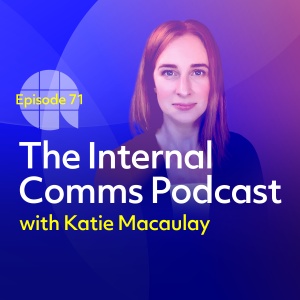
Episode 71 – Effective comms starts with knowing yourself
November 23, 2022
This week’s guest on The Internal Comms Podcast is Joanna Parsons, Head of Internal Communications & Culture at Teamwork. Joanna made Irish history as the first ever Head of Inte...

Episode 70 – Reaching across the aisle
November 9, 2022
Shelby Scarbrough, author of 'Civility Rules! Creating a Purposeful Practice of Civility', shares her deep insight and experience ‘reaching across the aisle’ on episode 70 of T...

Episode 69 – Measuring what matters – actions not feelings
October 26, 2022
Episode 69 of The Internal Comms Podcast sees IC heavyweight Mike Klein return to the hot seat. An internal and social communication consultant based out of Reykjavik, Mike is help...
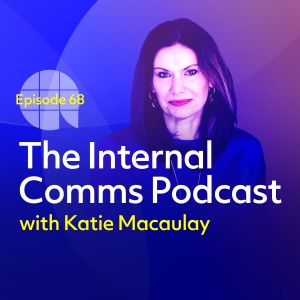
Episode 68 – Host in the hot seat: Reflections on 250,000 plays
October 12, 2022
In this very special episode of The Internal Comms Podcast, the tables have turned. Katie Macaulay is in the hot seat, and AB’s Senior Content Editor Freddie Reynolds takes over ...

Episode 67 – The ABC of research: Ask, believe, change
September 28, 2022
In this episode of The Internal Comms Podcast, host Katie Macaulay invites qualitative research expert Mari Lee to sit in the hot seat. Mari’s specialism is in ‘development com...
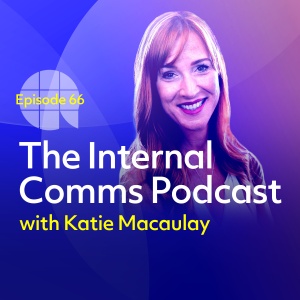
Episode 66 – Combatting IC isolation
September 14, 2022
The Internal Comms Podcast is back for what promises to be an incredible Season 8! In this kick-off episode, host Katie Macaulay welcomes ICology’s Vice President of Community an...
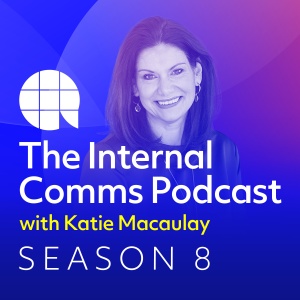
Season 7: The rewind episode
September 7, 2022
The countdown is on, and The Internal Comms Podcast will be returning from its summer break with Season 8 imminently. And while its eighth instalment promises wisdom unbound from a...

Episode 65 – Remote but not unreachable
June 22, 2022
In the final episode of season 7 of The Internal Comms Podcast, host Katie Macaulay speaks with Lily Goodman D’Amato, Delivery Trainer at US-based digital pharmacy Medly. Lily b...
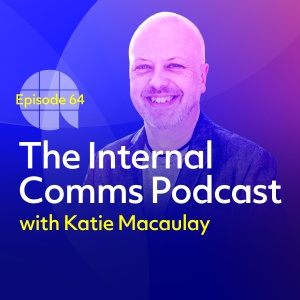
Episode 64 – Releasing your inner sceptic
June 8, 2022
In the latest episode of The Internal Comms Podcast, host Katie Macaulay speaks with Martin Flegg, founder and co-owner of The IC Citizen internal communications consultancy. With...

Episode 63 – Lessons in leadership
May 25, 2022
In episode 63 of The Internal Comms Podcast, host Katie Macaulay meets Mike Roe, who had a 28-year career in the police force and is now CEO of Tensense, a data insights company. ...

Episode 62 – Textbook IC: rewriting comms for a new era
May 11, 2022
In the latest episode of The Internal Comms Podcast, host Katie Macaulay speaks with the duo who wrote the book on internal communications – literally. Sue Dewhurst has worked i...

Episode 61 – Embracing the messiness of being human
April 27, 2022
In this week’s episode of The Internal Comms Podcast, host Katie Macaulay sits down with Victoria Dew, founder and CEO of Dewpoint Communications. Her firm is focused on helping ...

Episode 60 – How to have better conversations
April 13, 2022
In this week’s episode of The Internal Comms Podcast, host Katie Macaulay sits down with Jackie Stavros and Cheri Torres, co-authors of Conversations Worth Having, Using Apprecia...
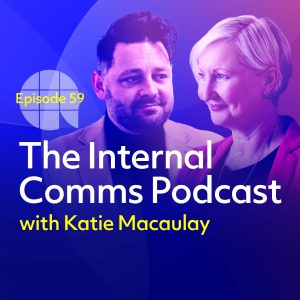
Episode 59 – Strategy & IC: A masterclass in collaboration
March 30, 2022
In this episode of The Internal Comms Podcast, host Katie Macaluay looks into the dynamic between internal comms and strategy – at its best a symbiotic relationship that drives t...
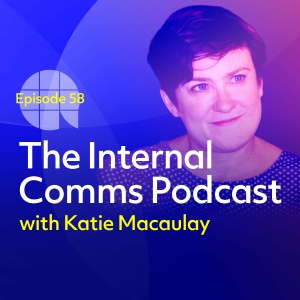
Episode 58 – The state of IC: what’s behind the numbers?
March 16, 2022
In episode 58 of The Internal Comms Podcast, we dissect the results of the latest State of the Sector report, the definitive global survey of the internal communication landscape, ...

Episode 57 – Unboxing internal comms at IKEA
March 2, 2022
In episode 57 of The Internal Comms Podcast, listeners can take a peek inside the world of IC at IKEA, as host Katie Macaulay chats with a dynamic duo from the multinational furnit...
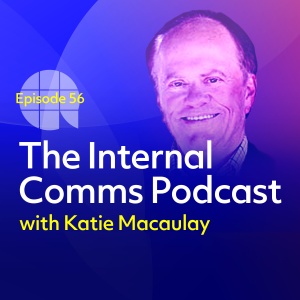
Episode 56 – IC at the sharp end
February 16, 2022
In this first episode of season 7 of The Internal Comms Podcast, host Katie Macaulay talks to Jim Shaffer, an internationally recognised business adviser, leadership coach, author ...
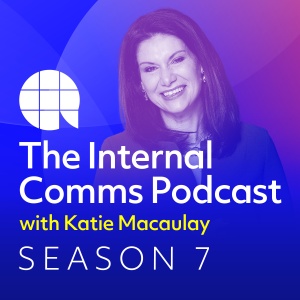
Leading Lights – Highlights From Season 6
February 9, 2022
Get ready to tune in to our next season of The Internal Comms Podcast. While Season 7 promises an amazing array of guests, this special episode highlights some of the best moments ...
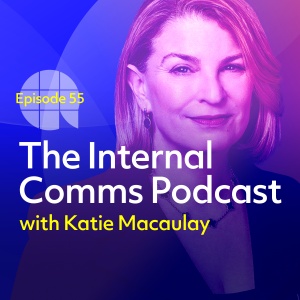
Episode 55 – Mission Possible
December 1, 2021
In the final episode of season 6 of The Internal Comms Podcast, host Katie Macaulay speaks to Sally Susman, Executive Vice President and Chief Corporate Affairs Officer at Pfizer. ...
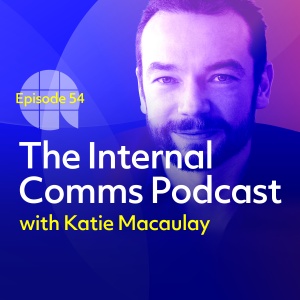
Episode 54 – Brain care: Mastering your mind
November 17, 2021
In the sixth episode of season 6 of The Internal Comms Podcast, host Katie Macaulay talks to Phil Dobson, founder of BrainWorkshops and author of The Brain Book: How to Think and W...

Episode 53 – Suicide Prevention: Reflecting on an award-winning campaign
November 3, 2021
***The content in this episode of The Internal Comms Podcast may be triggering for those who have experience of suicide.*** In the fourth episode of season 6 of The Internal Comms...
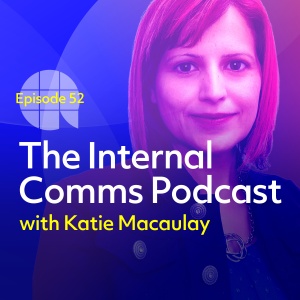
Episode 52 – How do you create comms with purpose?
October 20, 2021
In the fourth episode of season 6 of The Internal Comms Podcast, host Katie Macaulay catches up with Maliha Aqeel, Director of Global Communications and Digital Channels at Fix Net...

Episode 51 – Why are we here? How purpose and values drive healthy cultures
October 6, 2021
In the third episode of season 6 of The Internal Comms Podcast, host Katie Macaulay catches up with communications expert and IABC Fellow Jane Mitchell. Jane began her career with...
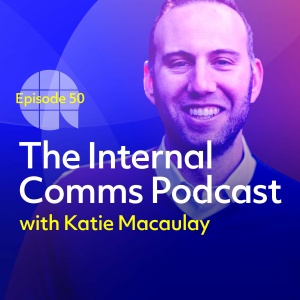
Episode 50 – A guru’s guide to internal podcasts
September 22, 2021
In the second episode of season 6 of The Internal Comms Podcast, host Katie Macaulay talks to Brian Landau, an authority in podcasting and expert on all things audio content creati...

Episode 49 – Engagement: how it started, how it's going
September 8, 2021
In this first episode of season 6 of The Internal Comms Podcast, host Katie Macaulay talks to the father of employee engagement, organisational psychologist Professor William Kahn....
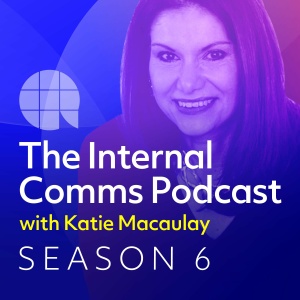
Industry experts – highlights from Season 5
September 1, 2021
The curtain is about to go up on the new season of The Internal Comms Podcast, with some fantastic guests joining host Katie Macaulay to talk about all things communication. For t...

Episode 48 – Changing minds: using behavioural science in IC
May 12, 2021
It has always been Katie Macaulay’s goal for The Internal Comms Podcast to help improve the way organisations communicate with their people, and this week she does so by explorin...
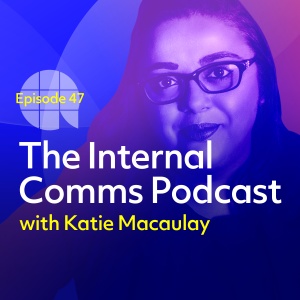
Episode 47 – Conversation with a comms rebel
April 28, 2021
Katie Macaulay’s guest this week is a leading light in efforts to advance the careers of under-represented groups in IC. Advita Patel is a qualified coach, mentor, public speake...
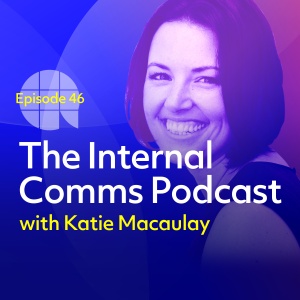
Episode 46 – Influential Internal Communication
April 14, 2021
This episode sees the return of the brilliant business communications strategist, international public speaker and podcast host Jenni Field. The immediate past chair of the Charte...
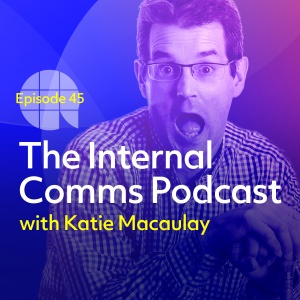
Episode 45 – Sharing the magic
March 31, 2021
The life and career of this week’s guest has been a literal roller coaster. Mark Webb fell into PR and media relations by chance, after spotting a job ad for the new Eurodisney ...
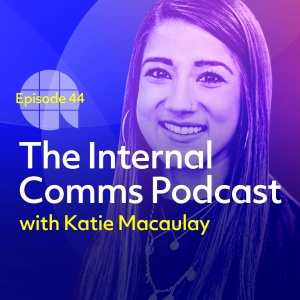
Episode 44 – How to prove your presence
March 17, 2021
Katie Macaulay’s guest for episode 44 of The IC Podcast is Canadian comms expert Prarthna Thakore. After beginning her career in Calgary and then moving to London, Prarthna has ...
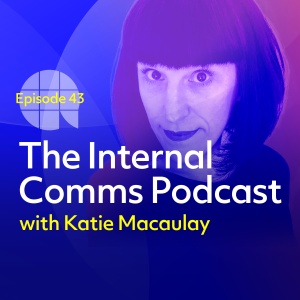
Episode 43 – Kate Jones on the state of our sector
March 3, 2021
Every year since 2008, internal comms pros have responded to the Gallagher State of the Sector report. Because it’s been running for 13 years, and because similar questions are a...
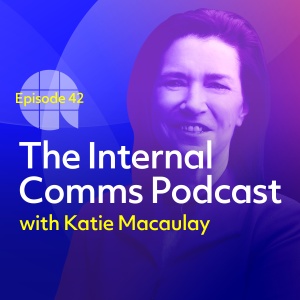
Episode 42 – Once Upon A Time In IC
February 17, 2021
Katie Macaulay kicks off Season 5 of The IC Podcast with a riveting conversation with business storytelling specialist Gabrielle Dolan. Gabrielle is a highly sought-after internat...

Looking back, looking forward: highlights from Season 4
February 10, 2021
With the new season of The Internal Comms Podcast just around the corner, we wanted to whet your appetite with a selection of the best bits from Season 4. For this special best-of...
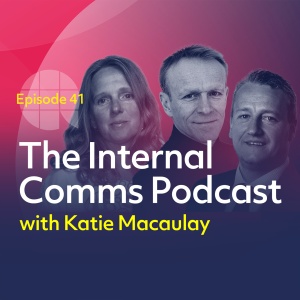
Episode 41 – At the heart of the crisis: NHS comms during Covid-19
December 23, 2020
The NHS has never been far from our hearts and minds over the last few months. As the national jewel in the UK’s crown, the National Health Service has battled many difficulties ...

Episode 40 – Founding fathers – building the first IC agency
December 17, 2020
What prompted the creation of the first IC agency back in 1964 and what convinced those first chief executives that they needed external help communicating with their employees? W...
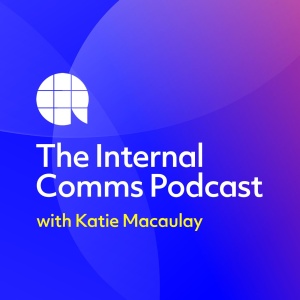
Coming soon in season 4
December 9, 2020
Coming soon in season 4 of The Internal Comms Podcast
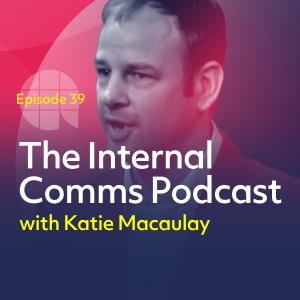
Episode 39 – Evidence-based IC
November 25, 2020
Recent research shows measurement is particularly challenging for many internal comms professionals. Katie’s guest on this episode of The Internal Comms Podcast is Benjamin Ellis...

Episode 38 – The secret thoughts of successful people
November 11, 2020
Amid the turmoil of 2020, with IC pros thrown into the spotlight as we strive to keep colleagues informed and connected, it’s not surprising that many of us are feeling a degree ...

Episode 37 – The art of negotiation
October 28, 2020
If you want to take your communication skills to the next level, then this episode of The Internal Comms Podcast is for you. Katie’s guest is a formidable negotiator and expert ...
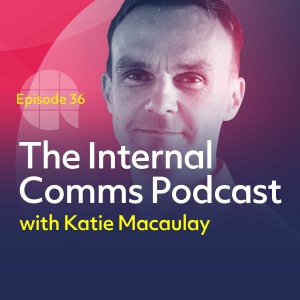
Episode 36 – Navigating the digital landscape
October 14, 2020
In this episode of The Internal Comms Podcast we meet digital expert Frank Wolf. Frank spent seven years as a business consultant at Accenture. Then at T Mobile, he was responsible...

Episode 35 – How to do less, but do it better
September 30, 2020
In this episode of The Internal Comms Podcast we meet Steve Crescenzo, a witty, straight-talking and charismatic speaker, workshop leader and coach from Chicago, USA, who has spent...
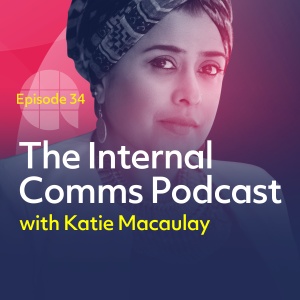
Episode 34 – Cross-cultural comms
September 16, 2020
The Internal Comms Podcast is now in its fourth season – and to kick it off Katie sat down with Tasneem Chopra for some honest and open conversation. The self-styled “professi...
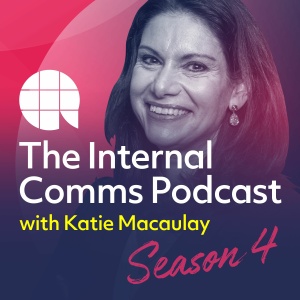
Choice cuts: highlights from Season 3 of The IC Podcast
September 2, 2020
Before the curtain lifts on Season 4 of The IC Podcast, we wanted to leave you with some food for thought from Season 3. And what a season it was; we had a whole host of remarkabl...
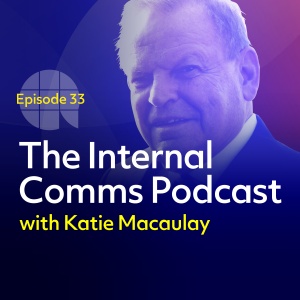
Episode 33 – IC’s founding father
July 8, 2020
The goal of this podcast is to bring you meaningful, in-depth conversations with people who are helping to shape the world of internal communication: practitioners, leaders, author...
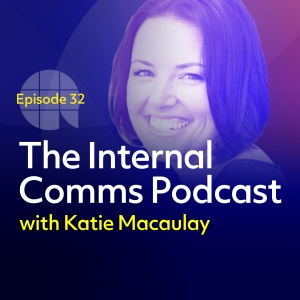
Episode 32 – Leadership in unprecedented times
June 24, 2020
President of the Chartered Institute of Public Relations (CIPR), Jenni Field has more than 16 years’ experience in communications. She is the founder and director of Redefining C...

Episode 31 – What's next? IABC roundtable on the impact of Coronavirus
June 10, 2020
The Internal Comms Podcast has gone truly global with our latest episode featuring three speakers from three countries. In episode 31 Katie tables a roundtable discussion with Jen...

Episode 30 – Your biggest, best, boldest self
May 27, 2020
Chief Executive of the Office for Nuclear Regulation (ONR), Adriènne Kelbie has an exceptional understanding of the true power of communication and engagement. The first woman to ...

Episode 29 – Crisis communication at the coalface
May 13, 2020
Katie’s guest this week is someone who is no stranger to crisis communication. Amanda Coleman was the Director of Corporate Communication at Greater Manchester Police when, on M...
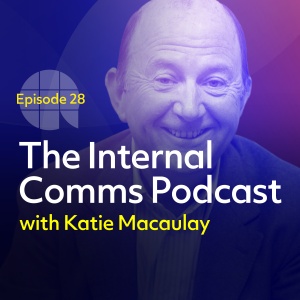
Episode 28 – The Godfather of IC
April 29, 2020
Katie’s guest this week is one of the world’s leading authorities on internal comms and the management of change: Bill Quirke. As managing director of IC consultancy Synopsis,...
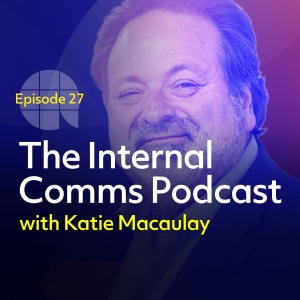
Episode 27 – Stepping up in a Crisis
April 14, 2020
This week Katie speaks to renowned communicator Shel Holtz. As listeners continue to grapple with keeping workforces informed, galvanised and feeling connected during the corona cr...
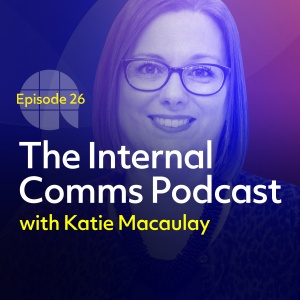
Episode 26 – How to thrive in IC (Part II)
April 1, 2020
This episode is recorded as the majority of the UK is in lockdown while the country attempts to flatten the curve of the COVID-19 pandemic. Katie Macaulay’s guest, Rachel Miller...
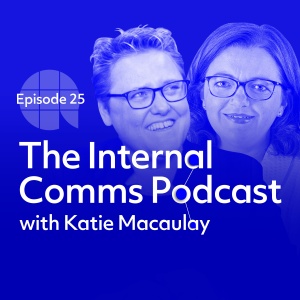
Episode 25 – Crisis Communications: Covid-19 Special
March 25, 2020
Katie Macaulay recorded this special episode on Friday 20 March 2020 in response to the rapidly developing situation surrounding the Covid-19 pandemic. Her guests to talk all thin...
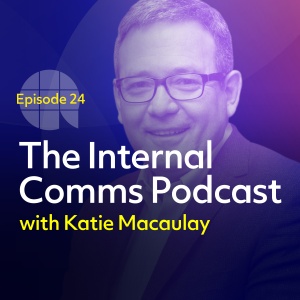
Episode 24 – A view from the top
March 18, 2020
In this episode of The Internal Comms Podcast, Katie puts her first CEO in the hotseat: Marc Barone. Marc is chief executive for continental Europe at AECOM. This Fortune 500 comp...
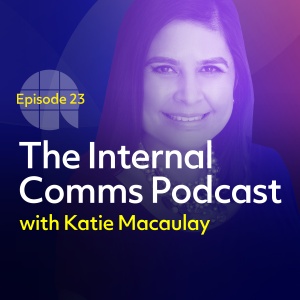
Episode 23 – Courage, confidence and communication
March 4, 2020
In this episode of The Internal Comms Podcast Katie talks to one of world’s most qualified communicators, Priya Bates, from Canada. Priya has an Accredited Business Communicator...
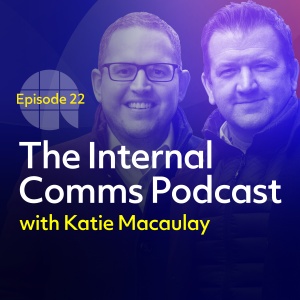
Episode 22 – State of the Sector
February 19, 2020
State of the Sector is the longest-established and most in-depth survey of the internal communication profession, based on responses from more than 1,000 professionals around the w...
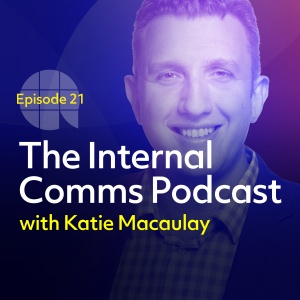
Episode 21 – The cheerleader for IC
February 5, 2020
During Seasons One and Two we covered a lot of ground in IC and beyond. As we begin Season Three, brace yourself for more fascinating insights as we delve into the very heart of co...
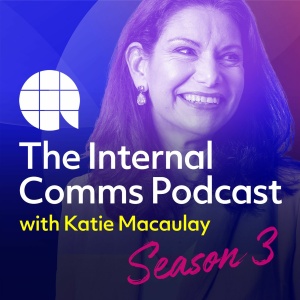
The highlight reel – nuggets of wisdom from Season 1 and 2 of The IC Podcast
January 29, 2020
Since the launch of The Internal Comms Podcast, host Katie Macaulay has interviewed more than 20 fascinating guests from the world of IC and beyond. Now, as we gear up for Season ...
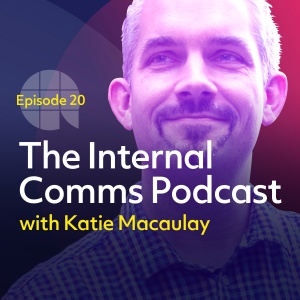
Episode 20 – Advocacy in action
December 18, 2019
Katie’s guest this week is Keith Lewis, UK Social Media and Social Business Manager for Zurich Insurance – one of the world’s largest insurance groups with 55,000 employees i...
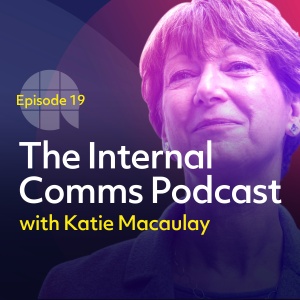
Episode 19 – The appliance of neuroscience
December 4, 2019
Katie Macaulay’s guest this week is a neuroscientist with extensive experience in the field of organisational change. Hilary Scarlett began studying the brain in 2009 after read...

Episode 18 – Editing organisations
November 20, 2019
In this episode we get up close and personal with someone who helps improve the way we communicate at work. Mike Klein worked as a political consultant in the US, but for the past...

Episode 17 – Black Belt Thinking
November 6, 2019
As individuals, this week’s guests have impressive CVs. Sue Dewhurst is an experienced internal communicator who, for many years, has been training and coaching thousands of lea...
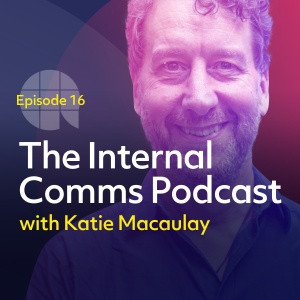
Episode 16 – A Passage to India
October 23, 2019
With this podcast now reaching listeners in 50 countries worldwide, host Katie Macaulay has chosen to go international for this episode. Her guest is creative services entrepreneu...
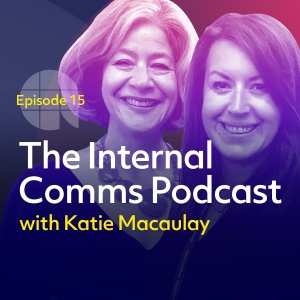
Episode 15 – The Power of Two
October 8, 2019
This week, Katie meets Claire Hyde and Louise Wadman, joint heads of IC at KPMG UK. Possibly the most senior IC job share in the country, Claire and Louise have more than 45 years...
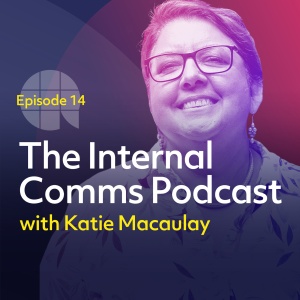
Episode 14 – How to start a movement
September 24, 2019
Katie’s guest this episode is Nita Clarke – whose services to employee engagement have earned her an OBE from the Queen. Nita has a long and fascinating career. She co-authore...

Episode 13 – A check-up with the IC doctor
September 11, 2019
The Internal Comms Podcast is back with a new series of fortnightly conversations with leading lights from the world of internal communications, engagement and leadership. AB Mana...
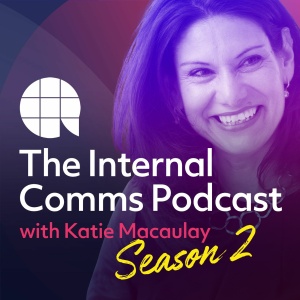
Season 02 Trailer
September 6, 2019
Season two of The Internal Comms Podcast is almost here!
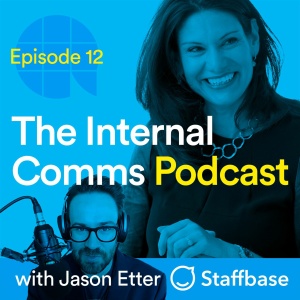
Episode 12 – Listen and learn: insights from 30 years in IC
July 24, 2019
In this extra special bonus episode of The Internal Comms Podcast, the tables are turned on Katie as she takes the spotlight as an interviewee. Posing the searching questions is J...
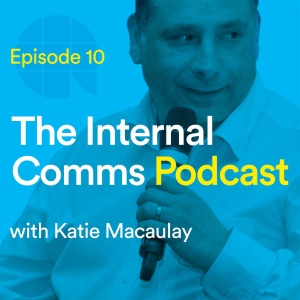
Episode 11 – Putting the soul back into Patisserie Valerie
June 25, 2019
For this special bonus episode of The IC Podcast, Katie interviewed Paolo Peretti, Managing Retail Director of Patisserie Valerie, in front of a live audience at AB Thinks Live, ou...

Episode 10 – Internal comms at the sharp end - recorded at IoIC live
May 21, 2019
For the final episode of season one, Katie Macaulay travels to Bath for IoIC Live and interviews two of the conference’s speakers, Martin Fitzpatrick and Matt Batten. Both Marti...
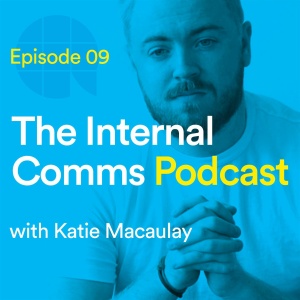
Episode 09 – How to win colleagues and influence people
May 7, 2019
Social influencer marketing is a new and rapidly growing means of getting your message out to your audience. It’s changed the face of advertising and has everyone from up-to-the-...
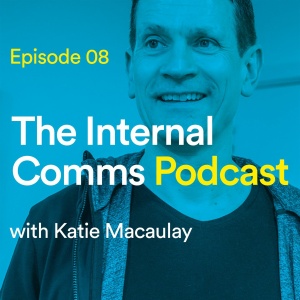
Episode 08 – The Joy of Work
April 23, 2019
Katie’s guest this week is an extremely versatile communicator. In his day job as European Vice President of Twitter, Bruce Daisley has overseen the development of one of the wor...

Episode 07 – What social purpose (really) means
April 9, 2019
Running the UK’s largest retail and financial services network with more branches than all of the UK’s banks and building societies put together, the Post Office is at the hear...

Episode 06 – The craft of communication
March 27, 2019
In episode six, Katie travels beyond the boundaries of internal comms to find out how to write more engagingly, tell better stories and use humour to deliver your message. And who ...

Episode 05 – Learning comms lessons from PR
March 13, 2019
In episode five, Katie aims to find out what internal communications can learn from external communications. So she sits down with ‘mister public relations’, Stephen Waddington...

Episode 04 – What it means to be the voice of IC
February 27, 2019
The Institute of Internal Communication (IoIC) is the voice of the IC profession – dedicated to strengthening confidence, credibility and community. And on 12 March, the IoIC cel...
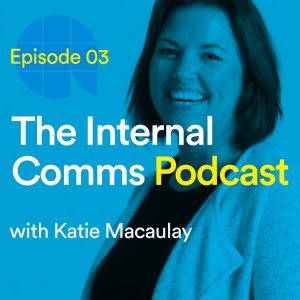
Episode 03 – What the State of the Sector report means for IC
February 13, 2019
Episode three lands as Gatehouse’s latest State of the Sector report is published. Katie invites Jenni Field, a tireless, high-profile personality of the IC landscape, to discus...

Episode 02 – What it takes to be an IC leader
January 30, 2019
Even if you’re only vaguely familiar with internal communications, Katie’s guest in episode two will no doubt be a name you recognise. In a career spanning 30 years, Russell G...
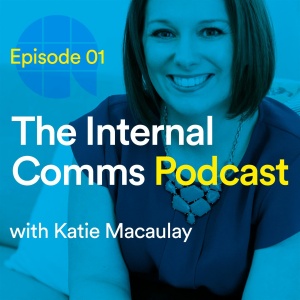
Episode 01 – How to thrive in IC
January 16, 2019
In the first episode of The Internal Comms Podcast, Katie meets Rachel Miller – a prolific blogger, educator, keynote speaker and one of the most respected voices in internal com...
